Results-driven leadership, clean audits and accountability: High impact while upskilling national and global industries
UIF
When do you pay; when can you claim?

SEPTEMBER | 2023
AFRICA’S
SOUTH
SOCCER TRAILBLAZER
OTHER NEWS NERSA loadshedding
of Practice
MATTERS
Desiree Ellis IN
Code
LEGAL
DR. FELLENG YENDE, CEO OF FP&M SETA


FA STES T ORM F O R 19 OCT 2023 n .c o .z a code to book your seat now




07 NOVEMBER 2023 Scan to Enter. ENTRIES NOW OPEN
SEPTEMBER
40 | Tourism and travel
A sector driving South Africa’s economic performance
46 | Elections
What electoral models do we use in South Africa
44 | Regional Focus
Transforming KwaZulu-Natal through job creation
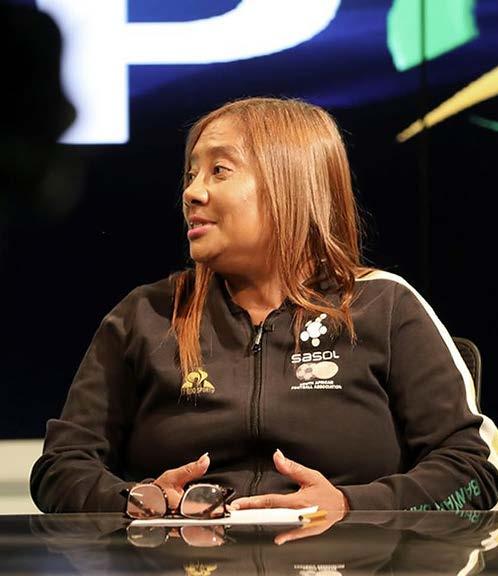


48 | Legal Matters
UIF: Providing a safety net for South African workers
50 | Financial Fitness
The National Credit Act: Protecting consumers against reckless lending
52 |
September is Heritage Month
04 | Public Sector Leaders | September 2023 Editorial Contents
2023
ISSUE 31
|
22 | BRICS
Expanding BRICS to promote the needs of the Global South
28 | UNESCO World Heritage sites Unveiling diversity and cultural richness of SA’s world heritage sites
32 | South Africa’s heritage
Preserving the heritage of freedom and liberation in South Africa
Features
34 | Lifestyle Celebrating our roots, celebrating our heritage 38 | Public Service Month Batho Pele: People first
10 | Addressing the Nation Building a better public service for a better South Africa 12 | Cover Story Dr Felleng Yende, CEO of FP&M SETA 26 | Trailblazer
Desiree Ellis: South Africa’s soccer trailblazer
36 | Women in Leadership
In Other
of
Deputy Minister Nocawe Mafu: Protecting heritage for future generations 42 |
News NERSA loadshedding code
practice
Upcoming Events
26
22 12
Reasons to choose GEMS for your healthcare needs
Reasons to choose GEMS for your healthcare needs
Reasons to choose GEMS for your healthcare needs
Reasons to choose GEMS for your healthcare needs
Reasons to choose GEMS for your healthcare needs
Reasons to choose GEMS for your healthcare needs
6. Primary Care Extender benefit – provides an additional R863 per year for the Emerald and Emerald Value options.
Scheme that prioritises access to affordable quality healthcare and rich benefits for you and your family.
quality healthcare and rich benefits for you and your family.
Join GEMS today and become a part of a Scheme that prioritises access to affordable quality healthcare and rich benefits for you and your family.
Join GEMS today and become a part of a Scheme that prioritises access to affordable quality healthcare and rich benefits for you and your family.
Join GEMS today and become a part of a Scheme that prioritises access to affordable quality healthcare and rich benefits for you and your family.
6. Primary Care Extender benefit – provides an additional R863 per year for the Emerald and Emerald Value options.
7. Largest HIV Disease Management Programme (DMP).
Join GEMS today and become a part of a Scheme that prioritises access to affordable quality healthcare and rich benefits for you and your family.






The Government Employees Medical Scheme (GEMS) is a restricted medical scheme providing accessible, affordable and rich benefits to qualifying Public Service employees and their nominated beneficiaries. GEMS currently provides
The Government Employees Medical Scheme (GEMS) is a restricted medical scheme providing accessible, affordable and rich benefits to qualifying Public Service employees and their nominated beneficiaries. GEMS currently provides quality healthcare to over 800 000 main members and over 2 million beneficiaries.
The Government Employees Medical Scheme (GEMS) is a






The Government Employees Medical Scheme (GEMS) is a restricted medical scheme providing accessible, affordable and rich benefits to qualifying Public Service employees and their nominated beneficiaries. GEMS currently provides quality healthcare to over 800 000 main members and over 2 million beneficiaries.
Top 10 reasons why GEMS is the best
Top 10 reasons why GEMS is the best
The Government Employees Medical Scheme (GEMS) is a restricted medical scheme providing accessible, affordable and rich benefits to qualifying Public Service employees and their nominated beneficiaries. GEMS currently provides quality healthcare to over 800 000 main members and over 2 million beneficiaries.
Top 10 reasons why GEMS is the best choice for you and your family
1. Lower contributions vs. open and closed schemes.
2. Contributions based on income.
3. Up to 100% subsidy for qualifying employees on salary levels 1 – 5 (terms and conditions may apply).
4. Broadest definition of beneficiaries – up to 5 generations can be covered!






5. No late joiner penalties.
6. Care Extender benefit – provides an additional R863 per year for the Emerald and Emerald Value options.
6. Primary Care Extender benefit – provides an additional R863 per year for the Emerald and Emerald Value options.
7. Largest HIV Disease Management Programme (DMP).
8. Close collaboration with Trade Unions and government stakeholders.
8. Close collaboration with Trade Unions and government stakeholders.
6. Primary Care Extender benefit – provides an additional R863 per year for the Emerald and Emerald Value options.
7. Largest HIV Disease Management Programme (DMP).
9. GEMS provides greater access to quality healthcare through a wide array of networks.
7. Largest HIV Disease Management Programme (DMP).
8. Close collaboration with Trade Unions and government stakeholders.
6. Primary Care Extender benefit – provides an additional R863 per year for the Emerald and Emerald Value options.
8. Close collaboration with Trade Unions and government stakeholders.
9. GEMS provides greater access to quality healthcare through a wide array of networks.
7. Largest HIV Disease Management Programme (DMP).
7. Largest HIV Disease Management Programme (DMP).
8. Close collaboration with Trade Unions and government stakeholders.
9. GEMS provides greater access to quality healthcare through a wide array of networks.
8. Close collaboration with Trade Unions and government stakeholders.
9. GEMS provides greater access to quality healthcare
10. GEMS offers comprehensive screening and preventative care benefits to its members. These benefits are available on all options and payable from the risk benefit for eligible members and dependants. This means that day-to-day benefits will not be affected.
10. GEMS offers comprehensive screening and preventative
10. GEMS offers comprehensive screening and preventative care benefits to its members. These benefits are available on all options and payable from the risk benefit for eligible members and dependants. This means that day-to-day benefits will not be affected.
9. GEMS provides greater access to quality healthcare through a wide array of networks.
10. GEMS offers comprehensive screening and preventative care benefits to its members. These benefits are available on all options and payable from the risk benefit for eligible members and dependants. This means that day-to-day benefits will not be affected.
Visit www.gems.gov.za for the eligibility criteria.
SMS 'Join' to 33165 today and join a medical Scheme that understands the needs of the South African Family and enjoy rich benefits
CREDITS
PUBLIC SECTOR LEADERS
The Digimag For Leaders In The South African Public Sector

Fully Accredited Member of ABC
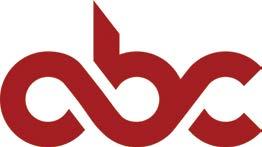
Advertising Sales, Distribution and Subscriptions
Top Media & Communications (Pty) Ltd
Tel: 086 000 9590
info@topco.co.za | www.topco.co.za
CEO Ralf Fletcher
TOPCO STUDIO
Production Director Van Fletcher van.fletcher@topco.co.za
Group Editor Fiona Wakelin fiona.wakelin@topco.co.za
ADVANCED CYBER SECURITY FOR YOUR BUSINESS
Assistant Editors Koketso Mamabolo koketso.mamabolo@topco.co.za
32
Sinazo Mkoko sinazo.mkoko@topco.co.za

Raine St.Claire raine.stclaire@topco.co.za
Contributors
Jessie Taylor
Design Tashwell Brown
Kerwin Pillay
Traffic Manager
Daniël Bouwer artwork@topco.co.za
SALES
National Project Manager
Emlyn Dunn
Tel: 072 1263962 emlyn.dunn@topco.co.za
Brand Coordinator
Sidney Phiri sidney.phiri@topco.co.za
Printers
LAW Print
Images
Digital Publishing Platforms
Issuu
For more than 30 years, ESET® has been developing industry-leading IT security software and services. Over 400,000 businesses and 110m users worldwide rely on us to deliver reliable, comprehensive protection.
Magzter
Media Carrier
Head Office
Top Media & Communications (Pty) Ltd T/A Topco Media
Elkay House, 186 Loop St
Cape Town

Tel: +27 86 000 9590
Fax: +27 21 423 7576
SECURE YOUR BUSINESS DATA, WITH ESET
Email: info@topco.co.za
Website: www.topco.co.za (ScanQRcodebelowtoviewwebsite)

iStock / Unsplash / Pexels / Flickr / GCIS
DISCLAIMER
All rights reserved. No part of this publication may be reproduced, stored in a retrieval system or transmitted, in any form or by any means, electronic, mechanical, photocopying, recording or otherwise, without the prior written consent of Top Media & Communications (Pty) Ltd T/A Topco Media. Reg. No. 2011/105655/07. While every care has been taken when compiling this publication, the publishers, editor and contributors accept no responsibility for any consequences arising from any errors or emissions.
06 | Public Sector Leaders | September 2023
10 50
ADVANCED CYBER SECURITY FOR YOUR BUSINESS
For more than 30 years, ESET® has been developing industry-leading IT security software and services. Over 400,000 businesses and 110m users worldwide rely on us to deliver reliable, comprehensive protection.
SECURE YOUR BUSINESS DATA, WITH ESET


EDITOR’S LETTER
BY FIONA WAKELIN

Letter from the Editor
Welcome to the September edition of Public Sector Leaders (PSL).
In his letter to the nation on 11 September, His Excellency Cyril Ramaphosa focussed on the theme of Public Service Month, drawing attention to the people who work in the country’s administration and their role in improving the lives of the citizens of South Africa.
His Excellency noted that there are 1.2 million public servants who are tasked with delivering on government’s mandate to build a better South Africa is through diligence, care and ethical conduct.
It has been a busy month for our public sector leaders, with President Cyril Ramaphosa attending the Opening Ceremony of the G20 Leaders’ Summit at the Bharat Mandapam International Exhibition Convention Centre in New Delhi, India and the Annual Police National Commemoration Day at the Union Buildings in Pretoria.
Our cover icon this month is Dr. Felleng Yende, CEO of FP&M SETA. “The world of industries is a dynamic realm, constantly reshaped by technological advancements, shifting socio-economic climates, and evolving consumer preferences. At the core of this ever-changing landscape stands the Fibre Processing and Manufacturing Sector Education and Training Authority (FP&M SETA), and at its heart is Dr. Felleng Yende. Her leadership has not only guided the FP&M SETA’s direction but has also played a pivotal role in the growth and revitalisation of numerous sectors”.
The September Trailblazer features Desiree Ellis, Banyana Banyana coach who led the team to their place in the World Cup this year. Desiree joined league football at the age of 15, with no idea that she would later become the first woman of colour to take charge of Banyana Banyana and also the first former player to coach the team.

“For me, it is not about fame and fortune; you have to have passion for this industry. Because I love the game so much, I practically trained every day and that is what kept me going”.
September marks Heritage Month and is a time when South Africans celebrate the cultural wealth of our country, remembering the history and cultures of our nation. This year Heritage Month will be commemorated under the theme of ‘Celebrating our cultural diversity in a democratic South Africa’. Protecting this heritage falls to the Department of Sport, Arts and Culture and our Woman in Leadership article this month focusses on Deputy Minister Nocawe Mafu. For your interest there are a number of articles on heritage, including proposed sites that mark the history of the struggle for democracy in our country.
In this edition we take a look at the all-important developments that took place at the BRICS Summit – resulting in what will be a much longer acronym. Our regional focus in KwaZulu-Natal and in Legal Matters there is very useful information on UIF – when you pay and when you can claim. In Other News we address what is on everyone’s mind – the NERSA load shedding code of practice - and before you lend money to anyone, read our Financial Fitness article on The National Credit Act! Next year the country goes to the polls in an extremely important election, hence our timeous article on the different models and how they work.
Whether you are in the public sector, the private sector, supply chain or an interested individual, PSL has something for you.
EDITOR

FIONA WAKELIN | GROUP
BY FIONA WAKELIN

ADDRESSING THE NATION
10 | Public Sector Leaders | September 2023
Building a better public service for a better South Africa
In his letter to the nation on 11 September, His Excellency Cyril Ramaphosa focused on the theme of Public Service Month, drawing attention to the people who work in the country’s administration and their role in improving the lives of the citizens of South Africa.
His Excellency noted that there are 1.2 million public servants who are tasked with delivering on government’s mandate to build a better South Africa through diligence, care and ethical conduct.
Public servants sign up to codes of conduct and the Batho Pele principles of courtesy, openness and transparency, maintaining service standards and giving best value when they enter into government employment at all three levels of public service - national departments, provincial and local government.
President Ramaphosa voiced the concern that “we often think that public servants are lacking in the provision of services to citizens and yet there are areas of distinction in the public service that don’t make the headlines.
“One speaks here about the committed civil servants behind frontline service counters, in our community clinics, at our border posts, in our foreign missions around the world, in our police stations and in our classrooms and at the forefront of scientific endeavour in our various institutions.
“These public servants get on with their tasks in relative anonymity, serving the South African people with diligence. One hears about situations when things go wrong, but one doesn’t hear about the thousands of people who every day apply for ID cards and passports in Home Affairs offices around the country, and who receive their documents in less than two weeks. Little is reported about the improvements brought about by the new Branch Appointment Booking system and e-service.
“While many citizens daily experience the orderliness, professionalism and courtesy of frontline service officials, the headlines and online debates are often reserved for public servants involved in corruption or mismanagement. It is correct that these activities be exposed and action taken against those responsible.
“We also need to recognise where progress is being made” – President Ramaphosa.

In the first week of September, His Excellency had outlined the steps being taken in departments to discourage corruption, including the completion of over 11 000 lifestyle audits of public servants in national government.
Towards the end of 2023, government will gazette several regulations to guide the implementation of the framework for the professionalisation of the public service that was adopted by Cabinet last year. These regulations will contribute to greater stability in the leadership ranks of the public service, ensure that recruitment processes are rigorous and that prospective public servants undergo competency testing before taking up positions.
“The implementation of the framework will improve the conditions of service for public servants and bring stability to departments that have undergone prolonged periods of uncertainty and flux. A better trained civil service that attracts suitably qualified individuals will engender greater public confidence.
“As we recognise the critical work of the public service and as we commend the many public servants who diligently serve the nation, we know that there is much room for improvement.
“It is for this reason that we have embarked on far-reaching public service reforms that will help build a state that is both capable and developmental; a state that both provides citizens with efficient frontline services and improves the quality of their lives,” – His Excellency. n
Public Sector Leaders | September 2023 | 11
Dr. Felleng Yende, CEO of FP&M SETA
Empowering industries through visionary leadership: A decade of impact
By Fiona Wakelin and Raine St. Claire
The world of industries is a dynamic realm, constantly reshaped by technological advancements, shifting socio-economic climates, and evolving consumer preferences. At the core of this everchanging landscape stands the Fibre Processing and Manufacturing Sector Education and Training Authority (FP&M SETA), and at its heart, you will find their visionary leader and CEO, Dr. Felleng Yende. Her leadership has not only guided the FP&M SETA’s direction but has also played a pivotal role in the growth and revitalisation of numerous sectors.
The Quintessential CEO, Dr. Yende embodies the qualities that define an exemplary Chief Executive Officer. She possesses the ability to define and nurture an organisation’s culture, develop short- and long-term strategies with measurable outcomes, instil a culture of accountability and excellence, and recognise and harness the talents of others to build high-performing teams. In an exclusive interview with Dr. Yende, we delve deeper into the FP&M SETA and how her exceptional leadership qualities and approach empower
individuals to take control of their destinies, positioning them as catalysts for positive change and sustainable economic development.
THE ROLE OF THE FP&M SETA I have a profound sense of achievement for the pivotal role that the FP&M SETA plays in skills development across a diverse array of sectors, ranging from clothing, footwear, textiles, furniture, and leather to woodworking, general goods, forestry, packaging, printing, print media, publishing, and pulp and paper. Our current strategy places a strong emphasis on the swift adoption of principles associated with the fourth industrial revolution (4IR). We are dedicated to addressing the evolving industry structures, embracing technology, and responding to shifting socioeconomic conditions.
At the FP&M SETA, we are committed to ensuring that individuals acquire the critical and often scarce skills essential for enhancing the sector’s capacity for long-term economic
sustainability and global competitiveness. Our dedication goes beyond just words; we back it with funding support and grants that facilitate access to the necessary training and development opportunities.
To further our mission, we actively seek out and address the training needs of employers through strategic partnerships and innovative delivery methods. We understand the importance of minimising costs while maximising impact, and this commitment underscores our approach to training and development.
Perhaps most importantly, we are passionate about equipping the next generation of workers, which includes youth and women, with not only the technical skills but also the values that will shape the nation’s future. By empowering individuals with these essential skills and values, the FP&M SETA is actively fostering positive change and driving sustainable economic development in our country.
12 | Public Sector Leaders | September 2023 COVER STORY FP&M SETA
CHARTING A PATH OF SKILLS DEVELOPMENT
The FP&M SETA’s expansive reach of these sectors underscores the organisation’s commitment to fostering skill development tailored to the unique demands of each sector. Our strategy places a strong emphasis on integrating fourth industrial revolution principles, while simultaneously adapting to the distinct nuances of each sector. This approach ensures that interventions remain not only effective but also sustainable, thus preparing the workforce to navigate the challenges and seize the opportunities presented by technology-driven transformations and evolving socio-economic conditions.
LEADING THE FP&M SETA’S REMARKABLE JOB CREATION INITIATIVES

I take great pride in our organisation’s significant strides in job creation, particularly in empowering youth and vulnerable groups within our sector. I am excited to share our notable initiatives and programmes that have contributed to these impressive achievements in job creation.

CAREER PORTAL: BRIDGING JOB SEEKERS, EMPLOYERS, AND TRAINING PROVIDERS
One of our standout initiatives is the Career Portal—an online platform designed to connect job seekers, employers, and training providers. This innovative platform allows users to upload their CVs, explore job opportunities, apply for learnerships, bursaries, and internships, and access career guidance and counselling services. The Career Portal serves as a valuable tool in connecting job seekers with employment opportunities and valuable skill-building resources.
TVET PARTNERSHIPS PROGRAMME: ELEVATING EDUCATION AND EMPLOYABILITY
At FP&M SETA, we understand the power of collaboration in job creation. Our TVET Partnerships programme exemplifies this approach by bringing together the FP&M SETA and various Technical and Vocational Education and Training (TVET) colleges. The primary goal of this programme is to enhance the quality and relevance of TVET education and training. By forging strong connections between TVET colleges and sector employers, we aim to promote employability and facilitate the seamless transfer of skills, ensuring that graduates are well-equipped for the demands of the job market.
Public Sector Leaders | September 2023 | 13
DR. FELLENG YENDE CEO OF FP&M SETA
IMPRESSIVE LEARNER REGISTRATIONS AND COMPLETIONS
Our dedication to job creation is evident in the remarkable numbers we achieved during the 2022/23 financial year.
3878 learners registered for leadership programme
3269 successfully completed learnerships
11 113 total learners registered
10 091 learner completions recorded
These consistent numbers underscore our unwavering commitment to providing accessible and effective training opportunities.
THE IMPACT STUDY: A TESTAMENT TO OUR SUCCESS
To gauge the impact of our programmes, we commissioned an impact study that delved into the learner experience and their transition from training to the world of work. The study yielded highly encouraging results. It confirmed that a substantial number of our learner graduates, including those completing learnerships, apprenticeships, skills programmes, internships, and bursaries, successfully transitioned to employment or self-employment. Specifically, in the 2021-22 period, 67% of learners in learnerships and 72% of apprentices in apprenticeships secured employment post-training, with approximately 10% venturing into self-employment.
GOVERNMENT SUPPORT
There is substantial support from government departments which began when the Honourable Minister of Higher Education, Science, and Innovation and Training established the FP&M SETA in 2011.
The government’s decision to cluster sectors was aimed at strengthening the value chain connections between related industries, a move that has had a profound impact on our organisation.

Sustaining economic growth and promoting skills development throughout the country is a commitment of the FP&M SETA. We align our
strategies closely with the government’s Economic Recovery and Reconstruction Plan (ERRP), which tackles long-standing structural constraints within our nation and provides a robust foundation for our efforts.
Playing a pivotal role in overseeing the FP&M SETA’s activities, the Department of Higher Education, Science, and Innovation ensures that our governance adheres to the highest standards. This adherence is facilitated by two essential acts: the Skills Development Act and the Public Finance Management Act, which together provide the necessary structure and oversight for our operations.
14 | Public Sector Leaders | September 2023
COVER STORY FP&M SETA
Our involvement in the ERRP encompasses various interventions, including:
1
SMME development
We actively promote the growth of Small, Medium, and Micro Enterprises (SMMEs), acknowledging their significance in economic advancement.
2 Incubation
We support entrepreneurship and provide business coaching, with a particular focus on township and rural development.
3 Employability initiatives
We prioritise addressing occupations in high demand within the FP&M industrial sectors, ensuring that the workforce is aligned with industry needs.
4 Innovation and technology adoption
We embrace innovation and the adoption of new technologies to enhance industry competitiveness.
One notable aspect of our engagement is our enthusiasm for implementing the industry Master Plan developed by the Department of Trade and Industry and Competition. This initiative holds significant promise for the growth and development of the sectors we serve, and we are excited to contribute to its success.
A DECADE OF LEADERSHIP IN THE FP&M SECTOR
I have had the privilege of serving as the CEO of the FP&M SETA for the past ten years, and it’s been an incredible journey witnessing the transformations within the sector. Over this time, we have witnessed significant shifts driven by economic changes, technological advancements, and evolving consumer preferences.
EMBRACING TECHNOLOGICAL INNOVATIONS
The sector’s enthusiastic embrace of technological innovations has been a defining feature. Automation, digital printing, and advanced machinery have enhanced efficiency, improved quality, and introduced innovative production methods. These advancements have propelled the sector forward and increased its competitiveness.
SUSTAINABILITY AT THE FOREFRONT
Environmental concerns have played a crucial role in shaping the sector. There is a profound emphasis on eco-friendly materials, waste reduction, and responsible resource management. Sustainability has become a driving force, aligning the sector with global environmental goals.
EXPANDING PRODUCT OFFERINGS
The sector has also expanded its product offerings, extending beyond traditional items. Clothing and textiles have begun incorporating smart textiles, and functional clothing has gained popularity. This diversification has opened up new opportunities and markets.
THE ROLE OF TRAINING AND RESKILLING
These transformations, coupled with rapid technological changes, have underscored the importance of upskilling and reskilling. The FP&M SETA has played a vital role in providing relevant training programmes, ensuring that the workforce remains adaptable to evolving industry demands.
Public Sector Leaders | September 2023 | 15
SIGNIFICANT MILESTONES ACHIEVED
In the 2022/2023 period, we achieved several remarkable milestones:
We supported 90 students in a skills development programme in the Eastern Cape and KwaZulu-Natal in partnership with the Department of Forestry, Fisheries, and the Environment.
We established the first Innovation Hub at the Richmond-Indaleni Skills Centre in rural Richmond, KwaZulu-Natal.
The Richmond-Indaleni Skills Centre Innovation Hub was expanded to provide hands-on learning solutions related to the fourth industrial revolution (4IR) and technologies, including spaces for robotics, virtual reality, and drone training.
We upgraded the Richmond-Indaleni Innovation Hub’s computer labs to include video conferencing and collaboration technology, along with high-speed Wi-Fi connections.
We funded 20 students’ participation in the Ngaphakathi Professionals project, which focuses on teaching furniture craftsmanship in Mpophomeni, KwaZulu-Natal.
We facilitated a sewing, garment-making, and fashion design skills workshop for 25 students in the Langa township in Cape Town.
We upskilled 35 inmates of the Boksburg Correctional Services in a cabinet making skills project.
We registered updated, fit-for-purpose occupational-directed qualifications in partnership with industry and the Quality Council for Trades and Occupations (QCTO).
We developed a Virtual Reality Application for training chainsaw operators in the forestry sector.
CHALLENGES AND PERSEVERANCE
Our journey has not been without challenges. As the sector evolves, so do our challenges. These include: addressing job losses in various FP&M industries due to economic downturns; educating companies on how to leverage government skills development strategies; developing new management and leadership skills for successful industrial strategies; ensuring that our qualifications align with sector workplace requirements; and adopting an integrated framework
for monitoring and evaluating performance and service delivery. To overcome these challenges, we remain committed to adaptability and innovation. We foster partnerships and stay closely attuned to the evolving needs of our stakeholders.
TECHNOLOGY’S IMPACT ON SKILLS DEVELOPMENT
As a 4IR expert, I see technology as a catalyst for both opportunities and challenges in South Africa’s skills development landscape.
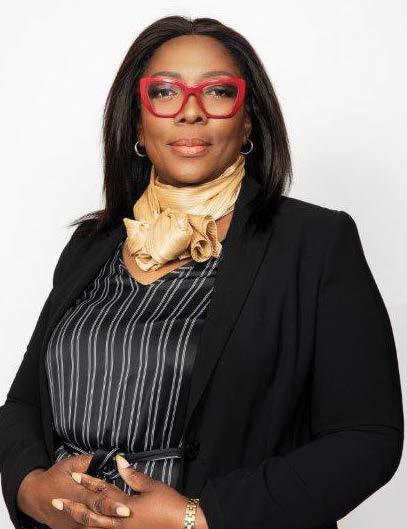
16 | Public Sector Leaders | September 2023
COVER STORY FP&M SETA
Technology allows us to offer convenient and adaptable learning experiences through online platforms, mobile devices, and digital tools, catering to diverse age groups and backgrounds. It empowers individuals to acquire new skills, refine existing ones, and transition into new careers that align with their passions and needs.
However, technology also presents challenges, including job displacement due to automation, artificial intelligence, and robotics. Low-skilled jobs may be replaced by machines or algorithms. To address this, collaboration with various stakeholders is essential. We must provide support and reskilling opportunities for affected workers, assisting them in transitioning to new roles or sectors.
MY MOTIVATION AND “WHY”
My motivation stems from the mission and vision of the FP&M SETA, which is to facilitate skills development and transformation within the sector. I am dedicated to empowering the youth and making them valuable contributors to the workforce. I firmly believe that our industry plays a pivotal role in South Africa’s economic and social development, from generating employment and contributing to exports to fostering innovation and promoting environmental sustainability.
My “why” is to make a positive impact on the lives of our stakeholders, particularly workers, employers, and learners within our sector. Providing them with access to high-quality education and training opportunities is my passion, enabling them to acquire relevant skills, knowledge, and competencies for the 4IR.
Leading a dynamic and diverse team of professionals who share my vision and values is an exciting endeavour. Together, we strive to cultivate a culture of excellence, collaboration, innovation, and accountability.
EXCITING PLANS FOR THE YEAR AHEAD
Looking ahead, we have ambitious strategic goals for the upcoming year. The FP&M SETA will continue to play a pivotal role in South Africa’s economic and social progress. Our focus will include occupations in high demand, achieved through the implementation of PIVOTAL (Professional, Vocational, Technical, and Academic Learning) programmes. These programmes encompass artisan development, work-integrated learning, and work experience for Higher Education and Training (HET) and Technical and Vocational Education and Training (TVET) graduates.
We plan to enhance and expand our partnerships with other skills development providers, such as TVETs and Community Education and Training (CET) colleges, to reach a broader audience of graduates and workers. Recognising the growing influence of the fourth industrial revolution (4IR), we will continue to prepare the workforce for technological changes by offering training in areas like data analytics, automation, and digitalisation. Sustainable practices will remain a focal point across sectors, contributing to South Africa’s growth and development.
A MESSAGE OF INSPIRATION
In these challenging times, I offer words of inspiration that truly reflect the remarkable spirit of our sectors. We have
encountered economic shifts, high unemployment rates, and the rapid advancement of technology, and yet, we have risen above these formidable challenges with incredible resilience, innovation, and adaptability.
Our sectors have been at the forefront of contributing to our nation’s progress. We have consistently delivered high-quality goods and services that meet the diverse needs of both local and national markets. This unwavering commitment to excellence has been a driving force behind our continued growth and success.
The advent of the fourth industrial revolution (4IR) has ushered in a new era, bringing with it both opportunities and demands. What sets us apart is our wholehearted embrace of this revolution. We have eagerly adopted cuttingedge technologies, honed our processes, and introduced innovative products that have not only boosted our productivity but have also elevated our quality and competitiveness on a global scale.
Change has been a constant companion on our journey, and we have learned to welcome it with open arms.
As we look to the future, I am filled with unwavering optimism about what lies on the horizon. Our resilience, innovative spirit, and adaptability have brought us to where we are today, and I have every confidence that these qualities will continue to propel us forward. We are on a path where success knows no bounds, and together, we will reach new heights, furthering our journey of growth and progress. n
Public Sector Leaders | September 2023 | 17
Sinayo Securities CEO, Babalwa Ngonyama Making a difference and lifting as she rises
Having established a thriving financial services company, Ngonyama is considered an industry maven who continues to make major waves in the corporate sector. Sinayo Securities is a majority black femaleowned member of the Johannesburg Stock Exchange (JSE). The firm provides financial services to institutional investors in South Africa, specialising in JSE-listed equity sales and trading.
MAKING A DIFFERENCE
Under Sinayo Securities and her personal capacity, Ngonyama leads several passion projects — most notably the company graduate training programme dubbed ‘Project Funda’. “This programme, which I am particularly passionate about, assists young graduates in the financial services sector by equipping them with the necessary knowledge and skills required for future employment. We accelerate their employment prospects by providing quarterly mentorship and
guidance,” says Ngonyama. To date, Project Funda has assisted more than 80 graduates to secure direct industry exposure, either with Sinayo Securities and/or its clients.
The acclaimed CEO is also the founding chairperson of the African Women Chartered Accountants (AWCA), an organisation whose key aim is to accelerate the development of black female Chartered Accountants. She currently serves on its Advisory Board.

Ngonyama is steadfast in her mission to make a positive difference in the world, a legacy she deems profoundly important.
“I have learned that my life becomes richer and fulfilled when I lend a helping hand — and I’m also reminded that life should not only be centred around my own needs,” says Ngonyama.
CAREER FACTS
Be it a corporate, entrepreneurial, philanthropic, or board role, there is no career hat which Ngonyama doesn’t wear without aplomb. Ngonyama has occupied diverse leadership roles — as a lead independent director and chairperson of various committees — with South African entities at various stages of their life cycles. She has a special knack for leading organisations with global operations in the most challenging jurisdictions.
The former Chief Financial Officer of Safika Holdings (Pty) Ltd and Group Chief Internal Auditor of Nedbank Ltd, Ngonyama has previously held many other key corporate and board positions. Until May 2019, Ngonyama was the Deputy Chairperson of Brand South Africa, a role that saw her work tirelessly to positively position South Africa globally.
18 | Public Sector Leaders | September 2023 INTERVIEW SINAYO
SECURITIES
Ngonyama has occupied diverse leadership roles as chairperson, a lead independent director, and director of various top 40 listed entities and companies with global operations in the most challenging jurisdictions, like Aspen Pharmacare, Implats, and Barloworld Group.
She is also the lead independent director on both the Hollard Life and Insurance boards and also chairs its risk committees.
A non-executive director and chairperson of Clover’s audit committee, she was commended by fellow board members for the proactive and instrumental role she undertook in helping conclude the company’s sale transaction. She also served as the Chairperson at the University of Cape Town Council.
LIFTING AS SHE RISES
Ngonyama was motivated to start Sinayo Securities in 2016, after years of realising how heavily burdened female professionals in the financial services sector were. “The financial services sector is largely maledominated, and females were subjected to racial
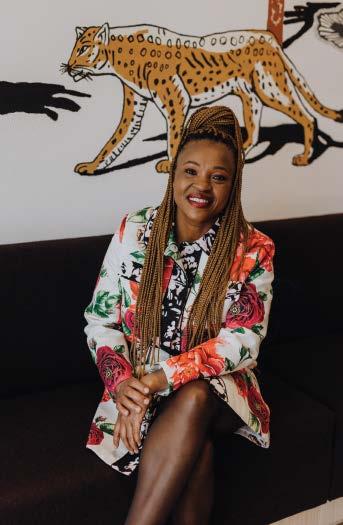

biases and gender inequality in the workplace,” shares Ngonyama.
From the beginning, she built the business on the foundation of experienced individuals and a strong entrepreneurial spirit, forming long-standing client relationships, and an ambition to leave a legacy of sustainable transformation and inclusivity in the stock broking industry. “Inclusion is not a matter of political correctness. It is the key to growth. She believes that, “Diversity and inclusion are the real grounds for creativity and are the key ingredients.”
“Corporate SA and the public sector can start by affording women more opportunities to elevate themselves in the workplace — and we will all reap the benefits of this empowerment. We need to lead the way for young professionals to have better opportunities and a chance to move the needle forward,” concludes Ngonyama.
Public Sector Leaders | September 2023 | 19
Building a Sustainable Future
EWSETA Revolutionises Skills Development in South Africa’s Energy and Water Industries
MPHO MOOKAPELE EWSETA CEO
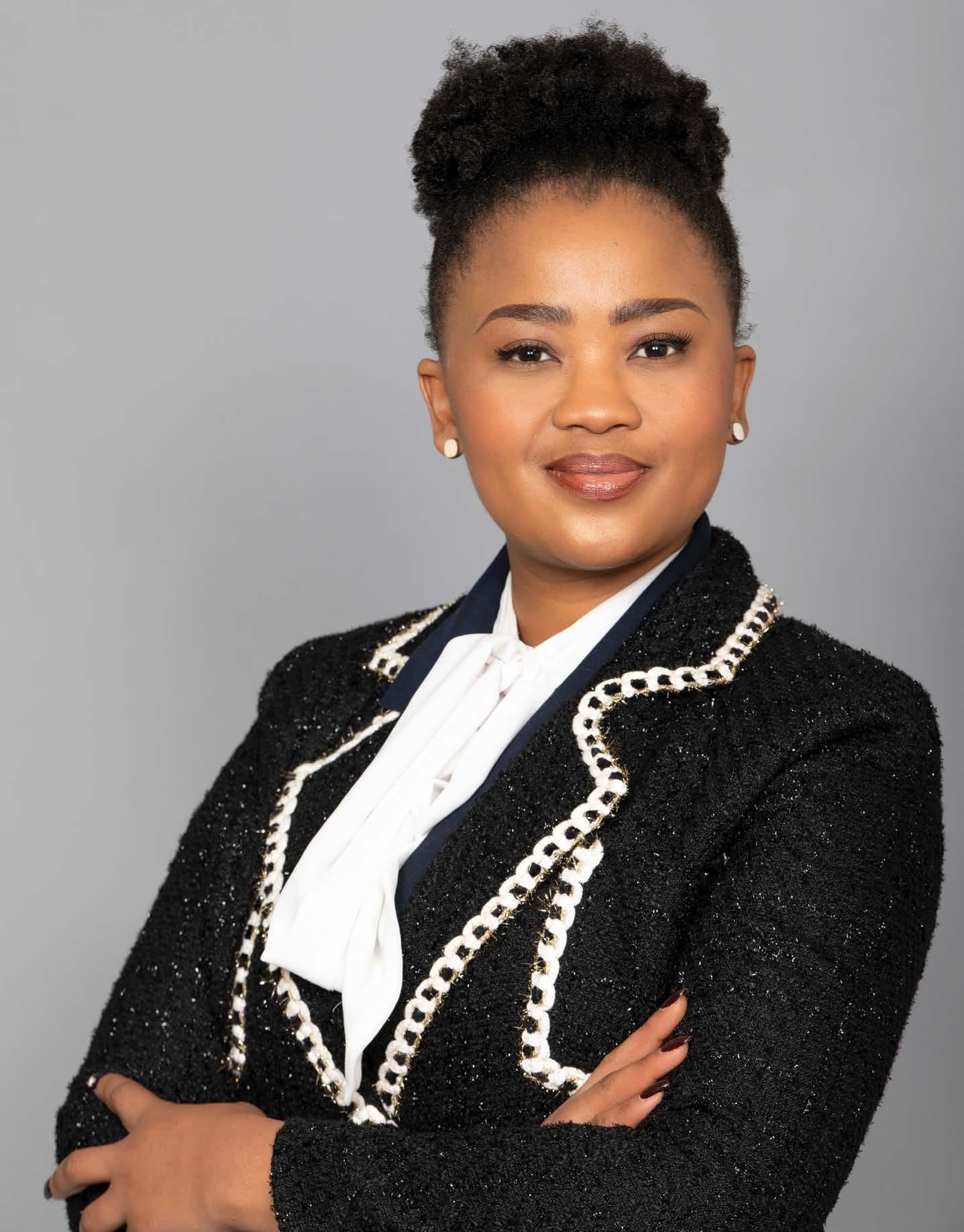
In our quest for a brighter and more sustainable future, we must tackle the pressing challenges in South Africa’s energy and water sectors. The shortage of skilled professionals not only hampers economic growth but also affects our communities’ well-being. But don’t worry, there’s hope! The Energy and Water Sector Education and Training Authority (EWSETA) is leading the way in addressing the skills gap through strategic partnerships.
South Africa’s energy sector is at a critical juncture, with a growing demand for electricity and an urgent need to transition to cleaner sources. The shortage of skilled professionals in renewable energy, energy efficiency, and
grid management exacerbates these challenges, making skills development crucial.
Let’s not forget about the water sector! South Africa is grappling with a water crisis, from scarcity to ageing infrastructure. Skilled professionals in water resource management, wastewater treatment, and infrastructure maintenance are essential for overcoming these obstacles and ensuring a sustainable water supply for all.
Recognising the importance of upskilling and reskilling, EWSETA has partnered with the government and municipalities. By working
closely with these stakeholders, EWSETA leverages its expertise and resources to advance comprehensive skills training programmes tailored to the public sector’s needs.
Mpho Mookapele, EWSETA’s CEO says, “Our strategic partnerships with the government and municipalities are instrumental in revolutionising skills development in South Africa’s energy and water industries. By aligning our programmes with national priorities and tailoring them to address the unique challenges faced at the municipal level, we are empowering professionals and municipalities to build a sustainable future and
ADVERTORIAL EWSETA
20 | Public Sector Leaders | September 2023
creating a skilled workforce that can navigate the complexities of these sectors and drive positive change for our nation.”
EWSETA partners with the government to align skills development initiatives with national priorities. They consult and collaborate to ensure that the recommended programmes align with the government’s energy and water sector strategies and directly address the challenges faced by the public sector.

EWSETA collaborates with municipalities to enhance the public sector’s capacity in the energy and water industries. By engaging directly with local authorities, EWSETA customises skills training programmes to tackle the unique challenges faced at the municipal level. This approach empowers municipalities to effectively manage and maintain their energy and water infrastructure.
The public sector faces several challenges in skills development, but EWSETA is actively addressing them through partnerships. Limited access to specialised
training, rapid technological advancements, an ageing workforce, lack of awareness, and limited collaboration are some of these challenges. However, through partnerships, EWSETA can extend its training programmes to remote areas and smaller municipalities, ensuring professionals across the country have access to specialised training opportunities.
Collaboration with the government and municipalities also enables EWSETA to advocate for the prominence of skills development in the water and energy sectors. By raising awareness and fostering a culture of continuous learning, EWSETA encourages professionals to enhance their skills and contribute to building a sustainable future.
Through collaborative efforts, EWSETA assists the public sector in developing effective succession plans and skills transfer mechanisms, mitigating the impact of an ageing workforce on operational efficiency. By investing in the workforce and equipping professionals with the right skills, we can build a sustainable future with a reliable energy supply, efficient
water management, and a thriving economy.
EWSETA recognises the urgency of developing a skilled workforce to tackle the challenges in the energy and water sectors. Through its partnerships, EWSETA encourages the development of various training programmes, providing individuals with the knowledge and practical skills needed to navigate these evolving sectors. Additionally, EWSETA offers apprenticeships, bursaries, and internships to create opportunities for young talent to learn, grow, and contribute to the industry’s future.
The challenges faced by South Africa’s energy and water sectors require urgent action and collaboration. EWSETA’s commitment to bridging the skills gap through partnerships with the government and municipalities is a testament to the pressing need for skills development and reskilling.
Together with EWSETA, the public sector can embrace this urgency and together build a resilient and prosperous nation for generations to come. n
Head Office info@ewseta.org.za 22 Wellington Road Parktown, Johannesburg +27 11 274-4700 ewseta.org.za Public Sector Leaders | September 2023 | 21
CONTACT DETAILS
BRICS
Expanding BRICS to promote the needs of the Global South

22 | Public Sector Leaders | September 2023
The recent BRICS Summit in South Africa has reaffirmed a partnership to promote the interests of the Global South while expanding collaboration with new members.
Announcing the outcomes of the Summit, President Cyril Ramaphosa, the current BRICS chairperson, said that six nations would join the BRICS bloc.
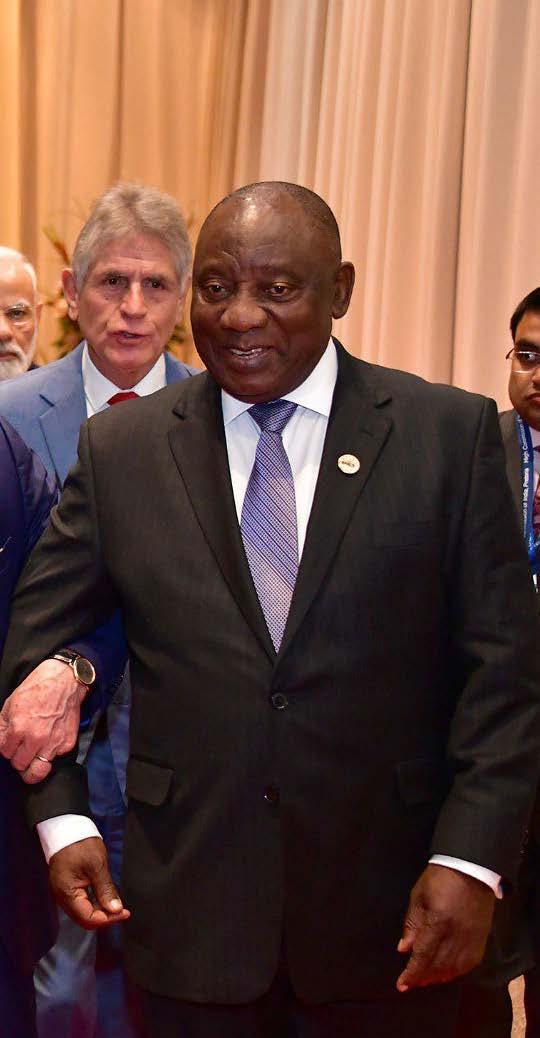
The 15th BRICS Summit took place at the Sandton Convention Centre in Johannesburg between 22 and 24 August. It is the first BRICS Summit to be hosted in person since the Covid-19 pandemic and the subsequent global travel restrictions.
The Summit provided an opportunity for BRICS leaders to engage each other, as well as the New Development Bank and the BRICS Business Council.
Leading up to the Summit, a wide-ranging BRICS business programme was aimed at attracting investment, promoting collaboration and showcasing opportunities within South Africa, Africa and BRICS countries.
A DIVERSE GROUP OF NATIONS WITH SHARED INTERESTS
President Ramaphosa announced that Argentina, Egypt, Ethiopia, Iran, Saudi Arabia, and the United Arab Emirates have been invited to become full members of BRICS. The membership will take effect from 1 January 2024.
President Ramaphosa said that BRICS is a diverse group of nations but is an “equal partnership of countries that have differing views but have a shared vision for a better world”.
“As the five BRICS countries, we have reached an agreement on the guiding principles, standards, criteria and procedures of the BRICS expansion process, which has been under discussion for quite a while. We have consensus on the first phase of this expansion process, and further phases will follow,” he said.
President Ramaphosa added that the current BRICS member states’ Foreign Ministers have been tasked with developing a BRICS partner country model and a list of prospective partner countries.
Public Sector Leaders | September 2023 | 23
The inclusion of additional nations is a significant step in the bloc expanding its reach and influence, and the new members will likely lead to a stronger coalition of developing nations that can promote the interests of the Global South.
More than 40 countries expressed interest in joining BRICS, and 23 formally applied to join. The six that were selected met the guiding principles, standards, criteria and procedures of the BRICS expansion process.
WORKING TOWARDS VIABLE SOLUTIONS
The expansion aims to create opportunities for BRICS nations to trade more easily with local currencies. This topic was discussed at length by member states during the Summit. “We have noted that there is global momentum for the use of local currencies, alternative financial arrangements and alternative payment systems. As BRICS, we are ready to explore opportunities for improving the stability, reliability and fairness of the global financial architecture,” said President Ramaphosa.
“The Summit agreed to task the BRICS Finance Ministers and/or Central Bank Governors, as appropriate, to consider the issue of local currencies, payment instruments and platforms and report back to the BRICS leaders by the next Summit.”
President Ramaphosa said that the Summit had allowed BRICS member states to discuss viable solutions for common challenges faced by the global South.

“We shared our vision of BRICS as a champion of the needs and concerns of the peoples of the Global South. These include the need for beneficial economic growth, sustainable development and reform of multilateral systems,” he said.
“We reiterate our commitment to inclusive multilateralism and upholding international law, including the purposes and principles enshrined in the United Nations Charter.”
BRICS is a partnership between Brazil, Russia, India, China and South Africa. The five emerging markets and developing countries combined make up 42% of the global population, 30% of the world’s territory, 23% of GDP and 18% of global trade.
The partnership is based on the shared commitment to restructure the global political, economic, and financial architecture to be fair, balanced and representative. At the heart of the partnership are the values of multilateralism and international law. The partnership was formed between Brazil, Russia, India and China in 2006, with South Africa joining in 2010.
More than 40 countries expressed interest in joining BRICS, and 23 formally applied to join. The six that were selected met the guiding principles, standards, criteria and procedures of the BRICS expansion process.
BRICS champions the interests of the broader global South. The member countries work towards practical cooperation in a spirit of openness and solidarity to find mutual interests and common values through more than 150 meetings annually. The meetings are in aid of political and security cooperation, financial and economic cooperation, and cultural and people-to-people cooperation. Over 30 agreements and memoranda of understanding provide a legal foundation for cooperation.
BRICS cooperation provides tangible benefits for South Africa through science, technology and innovation, energy, health, and education cooperation, as well as through BRICS financing for infrastructure development, capacity building, research, educational and skilling, trade, investment, and tourism opportunities. n
24 | Public Sector Leaders | September 2023
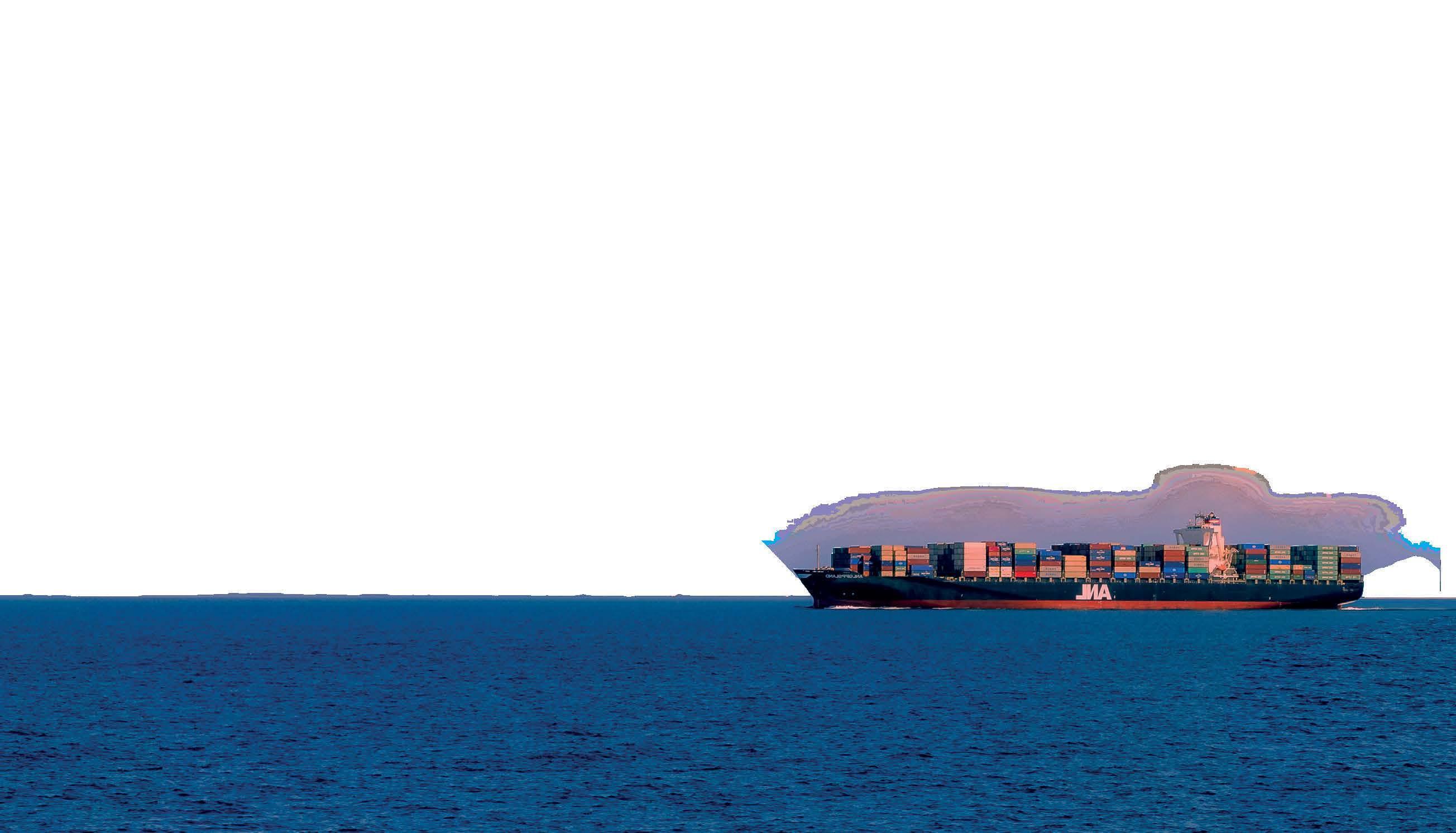

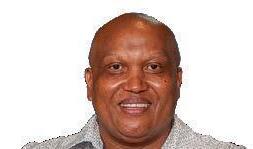










Desiree Ellis:
South Africa’s soccer trailblazer
Only a third of the coaches at the recent FIFA Women’s World Cup were women. And among the 12 coaches was Banyana Banyana coach Desiree Ellis. The dozen coaches were a record number for a sporting competition and significantly higher than in most other sports. But Desiree has long been a trailblazer in her field and an inspiration to sportswomen and young girls throughout South Africa and the continent.

LEADING THE WAY IN WOMEN’S FOOTBALL
Desiree led Banyana Banyana to their place in the World Cup almost 30 years after she lost her day job because she returned to work late after representing her country on the field. She played as part of the first squad of players to represent their country in a women’s football match and scored a hat trick against opponents eSwatini.
It took her almost 20 years, regularly representing her country, before she took up her coaching career. Between 2014 and 2016, she served as the national assistant coach under Vera Pauw, taking over the position in February 2018.
Under Desiree’s leadership, South Africa reached the Women’s Africa Cup of Nations (WAFCON) final in 2018, qualified for the World Cup
26 | Public Sector Leaders | September 2023
TRAILBLAZER BYJESSIE TAYLOR
Desiree Ellis, Banyana Banyana head coach
for the first time the year after, won WAFCON in 2022 and competed in the World Cup this year.
The 2023 FIFA Women’s World Cup took place from 20 July to 20 August and was jointly hosted by Australia and New Zealand.
A RISING STAR
Desiree was raised in Salt River, Cape Town, and showed a love for soccer even as a child. She would
Desiree was raised in Salt River, Cape Town, and showed a love for soccer even as a child. She would often get in trouble at school for jumping the school fence to play with the boys.
often get in trouble at school for jumping the school fence to play with the boys.
She went on to play for Banyana Banyana for nearly a decade, amassing 32 caps, and for eight of those years, she held the position of captain.
Much of her childhood consisted of street soccer matches played against teams from different streets, which would go on for hours. There is a mural of Desiree in Salt River in her playing days for Banyana Banyana.
The love for the game carried throughout the family, and her father, Basil, a keen footballer for a local club, took her to watch games between local clubs.
She says her father played a key role in shaping her career, and although he was very critical, he would be the loudest in stands when she scored goals.
“My father was very critical, and I think that made me the player and the person I am,” she recalls.

Desiree joined league football at the age of 15, with no idea that she would later become the first woman of colour to take charge of Banyana Banyana and also the first former player to coach the team.
“For me, it is not about fame and fortune; you have to have passion
for this industry. Because I love the game so much, I practically trained every day and that is what kept me going,” she says.
Among Desiree’s commendations was being awarded Confederation of African Football Women’s Coach of the Year in 2018 after her team finished second place in the African Women’s Cup of Nations and qualified for the Women’s World Cup for the first time.
Her contribution to the sport has been acknowledged through the awarding of South Africa’s Order of Ikhamanga in gold.
WHY SPORT IS IMPORTANT FOR GIRLS
Research has shown that participation in sports among girls can have numerous positive impacts on their lives.
Research led by UN Women and the Sport for Generation Equality Initiative has shown that sports can drive gender equality by teaching women and girls skills like teamwork, self-reliance, resilience, leadership and confidence. These, in turn, can reduce inequality between men and women in many other spheres of life: it can encourage female leadership in the workplace, reduce gender-based violence, and promote women’s equal economic participation. n
Public Sector Leaders | September 2023 | 27 Source: 702 | AFPAl Jazeera | Goal Ball Live | Mail and Guardian | Reuters | The Guardian
WORLD HERITAGE SIGHTS
BY RAINE ST.CLAIRE
UNESCO World Heritage Sights in SA


Journey into Splendour: Unveiling Diversity and Cultural Richness of South Africa’s UNESCO World Heritage Sites
South Africa’s landscape combines stunning beauty with remarkable diversity. It showcases a wealth of natural marvels, including mountains, forests, rock formations, beaches, deserts, and numerous geological features. Currently, South Africa proudly boasts ten UNESCO World Heritage Sites, recognised for their geological and cultural importance, meriting special recognition and protection beyond the national level according to UNESCO.
CULTURAL
Unveiling Human Origins: South Africa’s Fossil Hominid Sites feature dolomitic limestone terrain with caves, rocky formations, and lush valleys.
These sites are situated in Gauteng, Limpopo and North-west provinces and offer a treasure trove of scientific data, shedding light on human evolution over 3.5 million years, solidifying evidence that firmly establishes Africa as the Cradle of Humankind.
• Sterkfontein, Swartkrans, Kromdraai & Environs
The Cradle of Humankind in the
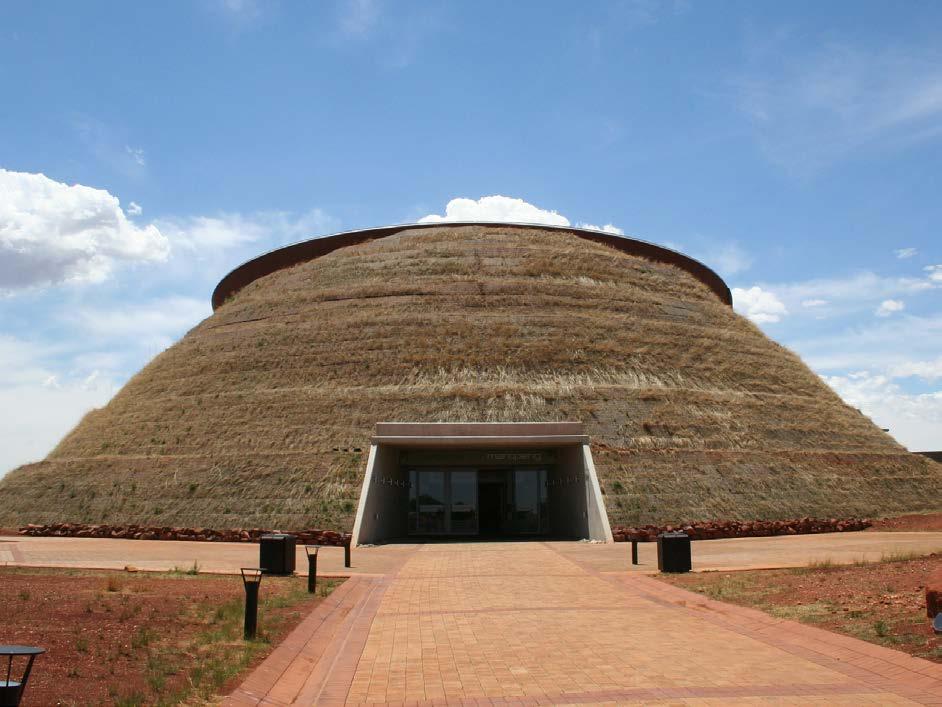
Gauteng province holds the clues to the origins of humankind dating back several millions years. It’s a place of scientific importance, especially the Sterkfontein Caves which housed the pre-human skull of Mrs Ples and the Little Foot hominid fossil and most recently Homo naledi skeleton discovered in the Rising Star Cave.
• Makapan Valley
Fossils in Makapan Valley’s caves identify early hominids, notably Paranthropus, dating from 4.5 million to 2.5 million years ago, alongside evidence of fire domestication from 1.8 million to 1 million years ago.
• Taung Skull Fossil Site
Taung Skull, a specimen of Australopithecus Africanus, was discovered in a Dart Pinnacle limestone quarry amidst numerous archaeological and paleontological sites southwest of Sterkfontein Valley.
2. THE MAPUNGUBWE CULTURAL LANDSCAPE

A Tale of Royalty and Evolution: Located within the Vhembe Biosphere Reserve, along South Africa’s northern border, where it meets Zimbabwe
and Botswana, the Mapungubwe Cultural Landscape encompasses an expansive savannah at the confluence of the Limpopo and Shashe rivers. Once a thriving kingdom, it was the largest in the sub-continent until its abandonment in the 14th century. What remains today are remarkably preserved palace sites, the interconnected settlement areas, and two preceding capital sites. This ensemble provides more than 1,000 rock art sites and an unparalleled glimpse into the evolution of social and political structures spanning 400 years.
3. THE RICHTERSVELD CULTURAL AND BOTANICAL LANDSCAPE (2007)

A Unique Fusion of Culture and Nature: Spanning 160,000 hectares in the rugged desert terrain of northwestern South Africa, the Richtersveld Cultural and Botanical Landscape represents a unique cultural and natural heritage. It is collectively owned and managed by the community. This site sustains the semi-nomadic pastoral lifestyle of the Nama people, reflecting seasonal practices that have endured for potentially over two millennia in southern Africa. Here, the Nama continue the tradition of crafting portable rush-mat houses known as “haru om” and engage in seasonal migrations, grazing activities, and the establishment of stock posts

28 | Public Sector Leaders | September 2023
1. FOSSIL HOMINID SITES OF SOUTH AFRICA
Triumph of Freedom Over Oppression: Robben Island’s significance lies in its grim history as a site of imprisonment and isolation for those deemed socially undesirable. With a history spanning the 17th to 20th centuries, the island served as a prison, hospital, and military base. Notably, it held political prisoners, including the renowned Nelson Mandela, and witnessed the victory of democracy and freedom over oppression and racism. Surviving elements include 17th-century quarries, the tomb of Hadije Kramat (1755), 19th-century administrative buildings, a chapel, a parsonage, a small lighthouse, the lepers’ church, remnants of a leper colony, WWII military structures near the harbour, and the stark maximum security prison of the Apartheid era (from the 1960s).
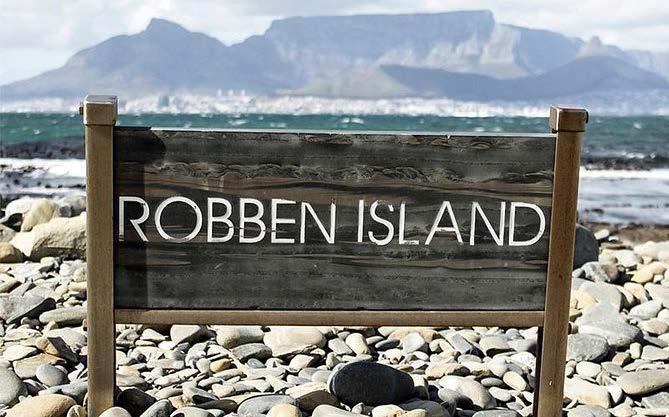
culture of the once-nomadic ǂKhomani San people and their innovative strategies for surviving harsh desert conditions. Their distinct ethnobotanical knowledge, cultural rituals, and worldview, tied to the region’s geographical features, emerged. Over millennia, the ǂKhomani Cultural Landscape narrates the enduring lifestyle that shaped this area.


NATURAL
of Archaean lavas and sediments has remained largely untouched by both metamorphism and erosion. The geosites offer among the oldest evidence of ocean and atmosphere chemistry, as well as the mechanisms behind continent formation – distinct characteristics of our planet. The property’s significance lies not only in the remarkably preserved geosites but also their abundance and close proximity. With numerous captivating geosites, the Barberton Makhonjwa Mountains weave an incompletely explored yet coherent narrative about the origins of life on Earth.
An Ancient Desert Adaptation: Situated at the northern border adjoining Botswana and Namibia, the ǂKhomani Cultural Landscape encompasses the Kalahari Gemsbok National Park. This expansive sandy terrain holds a record of human habitation spanning from the Stone Age to the present. It reflects the
A Glimpse into Earth’s Ancient Past: The Barberton Makhonjwa Mountains house an extraordinary record of some of Earth’s earliest and bestpreserved volcanic and sedimentary rocks, showcasing their diversity. These geological formations have been meticulously examined for over a century, unveiling critical insights into early Earth processes. These include the emergence of continents, the conditions on the surface 3.5 to 3.2 billion years ago, and the environment that fostered the dawn of life.

Shielded by extensive granite masses and buried beneath layers of sedimentary rock, this unbroken 340-million-year-long chronicle
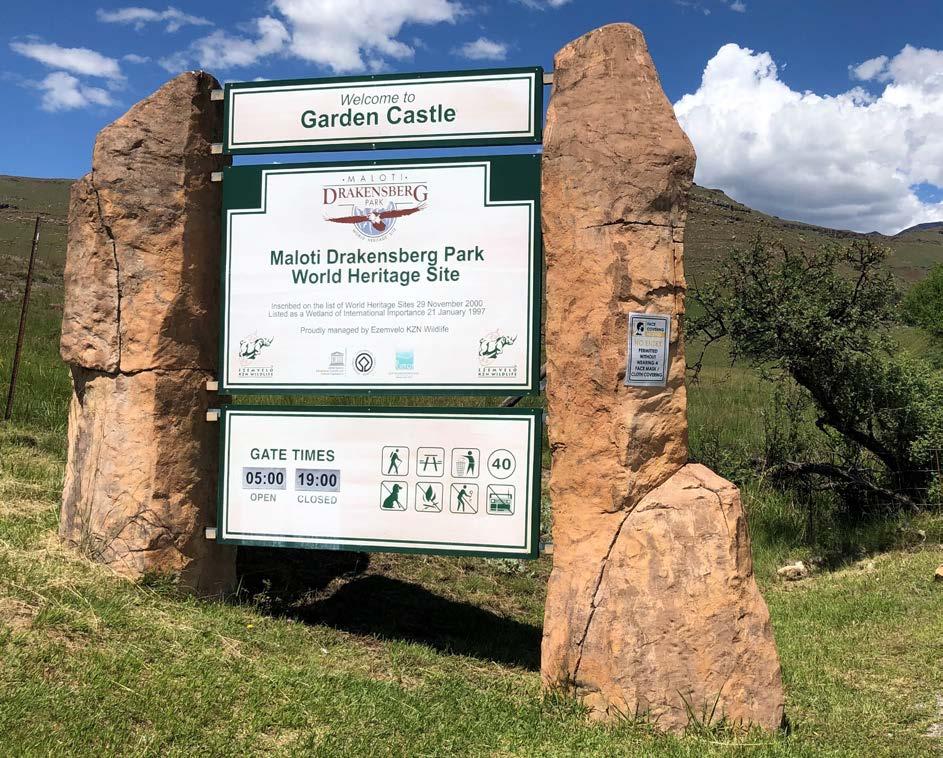
A Biodiversity Hotspot: The Cape Floral Region is celebrated globally for its exceptional plant diversity and unparalleled endemic species. Recognised as a World Heritage Site in 2004, it occupies the southwestern part of South Africa, a hotspot of terrestrial biodiversity. Among the world’s six Floral Kingdoms, it stands out as a unique phytogeographic unit, notable despite its small size. Identified as a “hotspot,” it shelters diverse endangered plants and showcases vital ongoing ecological, biological, and evolutionary processes. Preserving this extraordinary collection

Public Sector Leaders | September 2023 | 29
4. ROBBEN ISLAND (1999)
5. ǂKHOMANI CULTURAL LANDSCAPE (2017)
6. BARBERTON MAKHONJWA MOUNTAINS (2018)
7. CAPE FLORAL REGION PROTECTED AREAS (2004, 2015)
species with more than 670 plant species and it is the only area in the world where three recognised biodiversity hotspots converge: Fynbos, Succulent Karoo and Maputo PlantTogoland-Albany.
Even the arid inland portion of the reserve is rich in endemic species with at least 400 plant species.In terms of fauna, the reserve plays an important role in conserving two unique and threatened populations of Cape mountain zebra and Bontebok. Populations of leopards are also present in most of the mountainous areas. Threatened invertebrates include seven endemic species of the enigmatic beetle genus Colophon and 14 endemic butterfly species.
• Kogelberg Biosphere Reserve
South Africa’s inaugural biosphere reserve lies approximately 40 km from Cape Town within the Western Cape Province. Encompassing 103,629 hectares, over 80% of this area is characterised by mountainous terrain, including towering peaks, deep valleys, and gentle hills, alongside lower mountain slopes hosting apple farming and commercial pine plantations. The remaining portion encompasses a softly undulating coastal plain and a marine expanse spanning around 24,500 hectares. Along the coastline, rocky formations predominate, interspersed with sandy beaches and estuaries.
8. iSIMANGALISO WETLAND PARK (1999)
Thriving Ecological Variety and Biodiversity: The Zulu term “iSimangaliso” translates to ‘wonderful place’ or ‘land of miracles’. Situated along South Africa’s KwaZulu-Natal Province coastline, iSimangaliso WetlandPark is classified as a UNESCO Ramsar site, acknowledging wetlands’ ecological roles and their value as economic, cultural, scientific, and recreational resources, including no less than four wetlands of international importance status:
• Kosi Bay
This area features four interconnected lakes with tidal influence, an estuarine channel, and extensive swamps. It is
Source: https://whc.unesco.org/en/statesparties/za
sustained by three permanent rivers and includes habitats like swamp and mangrove forest, reedbeds, dune systems, associated woodland, and coastal grassland. A diverse array of invertebrates, fish species, birds, mammals, butterflies, and plants, many of which are endemic, threatened, or endangered, thrive here.
• Lake Sibaya
As South Africa’s largest natural freshwater lake, Lake Sibaya is separated from the ocean by forested dunes. It encompasses swamp forests and wet grasslands and is home to various endangered or endemic species of reptiles, fish, birds, mammals, and plants. The lake supports an array of aquatic and terrestrial molluscs, zooplankton, and unique South African flora and fauna.
• St. Lucia System
Covering 155,000 hectares, this system comprises coastal dune forests, freshwater wetlands, grasslands, and estuarine lake systems. It is the largest of South Africa’s three estuarine coastal lake systems, serving as a vital nursery for juvenile marine fish and prawns. The area hosts significant populations of Nile crocodiles, hippopotamuses, White pelicans, and Pink-backed pelicans.
• Turtle Beaches/Coral Reefs of Tongaland
Turtle Beaches/Coral Reefs of Tongaland: Spanning 155 kilometres of coastline, this marine reserve boasts sandy beaches alternating with rocky reefs containing coral formations on sandstone reefs within 3 nautical miles of the shore. This area is a prime nesting and breeding ground for the Endangered Loggerhead turtle and Vulnerable Leatherback turtle. The marine protected areas exhibit high fish species diversity, including the Coelacanth, a critically endangered living fossil discovered near Sodwana Bay.
9. VREDEFORT DOME (2005)
Earth’s Ancient Impact Site Revealing Geological Secrets: Located about 120
km southwest of Johannesburg, the Vredefort Dome represents a segment of a larger meteorite impact structure, or astrobleme. Dating back 2,023 million years, it holds the distinction of being Earth’s oldest known astrobleme. Spanning 190 km in radius, it also stands as the most expansive and deeply eroded. The Vredefort Dome serves as a testament to the planet’s most significant singular energy release event, which triggered far-reaching global consequences, potentially influencing major evolutionary shifts as proposed by some researchers. This site offers crucial insights into Earth’s geological timeline and plays a pivotal role in unravelling the planet’s evolution. Despite the impact sites’ historical significance, many have lost their traces due to surface geological activity. Vredefort remains the sole example providing a comprehensive geological profile of an astrobleme beneath the crater floor.
MIXED
10. MALOTI-DRAKENSBERG PARK (2000, 2013)
A Transnational Haven of Breathtaking Natural Beauty: The Maloti-Drakensberg Park encompasses both the uKhahlamba Drakensberg National Park in South Africa and the Sehlabathebe National Park in Lesotho. This exceptional transnational site boasts breathtaking natural allure, showcased in its towering basaltic buttresses, striking cutbacks, and gleaming sandstone ramparts. It also features visually captivating sculpted arches, caves, cliffs, pillars, and rock pools. The park’s varied habitats provide a sanctuary for a wealth of endemic and globally significant plant species. Within its bounds, endangered creatures like the Cape vulture and the bearded vulture find refuge. Lesotho’s Sehlabathebe National Park shelters the critically endangered Maloti minnow, a fish species exclusively found in this region. This remarkable natural reserve is home to numerous caves and rock-shelters adorned with Africa’s largest and most concentrated array of paintings south of the Sahara. These depictions offer a window into the spiritual life of the San people, who inhabited this area for over 4,000 years. n
30 | Public Sector Leaders | September 2023
Brainfood
for business.
Take a journey away from short termism and start looking at a better future. Meet the interesting people changing Africa – and the way we work, think and live.

LISTEN NOW
SOUTH AFRICA’S RICH HERITAGE
BY SINAZO MKOKO
Preserving the heritage of the freedom and liberation struggle in South Africa
Ten liberation sites in South Africa have formed part of the UNESCO World Heritage nomination, which is hoped to be discussed at the next session of the World Heritage Committee in 2024.
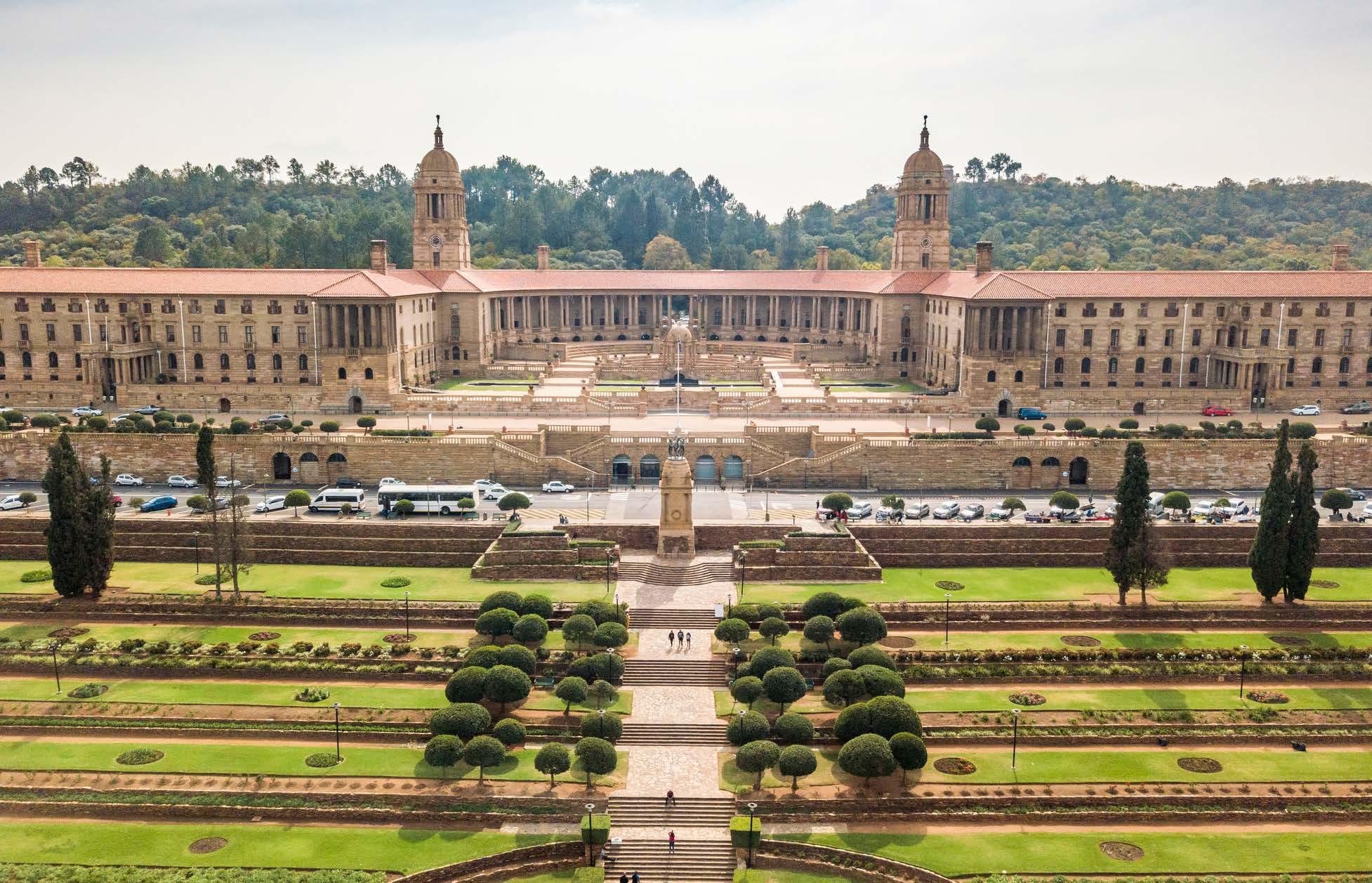
A representative and heritage expert for the International Council on Monuments and Sites (ICOMOS), Charles Akibode, visited South Africa last month to evaluate Liberation Heritage sites on behalf of the United Nations Educational, Scientific, and Cultural Organisation (UNESCO).
The ten sites, including the Union Buildings, are Walter Sisulu Square, Sharpeville Massacre, Memorial and Graves Site: Police Station, Liliesleaf, 16 June 1976; The Streets of Orlando West, Constitution Hill, Ohlange Institute, University of Fort Hare and ZK Matthews House,
Waaihoek Wesleyan Church and The Great Place at Mqhekezweni. These have been selected to form a serial nomination of the next world heritage sites in South Africa.
Relevant stakeholders from various departments and agencies, including the National Heritage Council (NHC), the South African Heritage Resources Agency (SAHRA), and the Department of Sports, Arts, and Culture, were in attendance at the reception of the heritage expert by the Presidency on August 3.
The nomination is called Human Rights, Liberation Struggle, and Reconciliation: Nelson Mandela Legacy Sites, and they are all related to the liberation heritage in South Africa and are anchored on the principles of human rights, liberation, and reconciliation.
According to the National Heritage Council, the process is expected to take 16 months to complete from the date the organisation received the nomination from the UNESCO World Heritage Centre, which was in March.
The NHC is an agency of the Department of Sport, Arts and Culture with a mandate to preserve, protect, and promote the country’s heritage.
The Heritage Council stated that this visit was the culmination of work that started ten years ago when a decision was made to preserve the heritage of the freedom and liberation struggle in South Africa.
Charles explained that following this report, there will be a desk review, which will consist of a
32 | Public Sector Leaders | September 2023
written report by an expert on the significance of the site that has been nominated for inscription on the World Heritage List or on more specialised topics such as cultural tourism management, risk mitigation at the site level, and management and protection features.
The National Heritage Council said this initiative was inspired by a UNESCO meeting that was hosted by South Africa in 2005.
“The Roads to Independence: African Liberation Heritage’ Programme (ALHP) was adopted in 2005 at the 33rd General Conference of UNESCO, recognising struggle heritage as being of universal value and significance.” They said one of the key resolutions was to increase and balance the world heritage sites in Africa.

“When embarking on preserving the story of the “Roads to Independence” for Africa, the South African chapter focused on telling its tale through the “Resistance and Liberation Heritage Route”. It is this project that the Department of Sport, Arts, and Culture has assigned to its agency, the National Heritage Council, to implement,” they said.
“This watershed moment is a culmination of years of work, consultations, research, interactions, workshops, side events, revisions, and reiterations of the nomination dossier, to the point where it is now. This dossier has walked a remarkable journey, has undergone significantly elaborate scrutiny at different levels, and has benefited from the wisdom and passion of diverse people in the country, the continent, and the world,” said NHC.
ABOUT THE SOUTH AFRICAN HERITAGE RESOURCES AGENCY (SAHRA)
SAHRA is a statutory organisation established under the National Heritage Resources Act, No 25 of 1999, as the national administrative body responsible for the protection of South Africa’s cultural heritage. The organisation coordinates, monitors and promotes the management of the country’s heritage resources not only for community development and social well-being but also for the benefit of present and future generations. SAHRA also provides guidance to the communities in the areas where National Heritage Sites are found.
ABOUT THE NATIONAL HERITAGE COUNCIL (NHC)
This is a Schedule 3A public entity, and an agency of the Department of Sport, Arts and Culture.
With a mandate drawn from the White Paper on Arts and Culture in Section 4 of the National Heritage Council Act no. 11 of 1999, the NHC aims to:
• Develop, promote and protect the national heritage for present and future generations.
• Coordinate heritage management.
• Protect, preserve and promote the content and heritage which resides in orature in order to make it accessible and dynamic.
• Integrate living heritage with functions and activities of the Council and all other heritage authorities and institutions at national, provincial and local levels.
• Promote and protect indigenous knowledge systems including but not limited to enterprise and industry, social upliftment, institutional framework and liberatory processes: and
• Intensify support for the promotion of history and culture of all our peoples and particularly to support research and publications on enslavement in South Africa.
Public Sector Leaders | September 2023 | 33 Source: UNESCO | NHC | SA Gov | SAHRA |
LIFESTYLE
BY SINAZO MKOKO
Celebrating our roots, celebrating our heritage
It’s September, and while we know that spring does not really start on the first day of the ninth month, there are many many ways we can celebrate that spring has indeed sprung in South Africa. Here, we list four activities that you can do this September, alone or with your loved ones.
SOUTH AFRICAN CHEESE FESTIVAL, WESTERN CAPE
This is one of the greatest outdoor events in the Mother City, where real cheesemongers and wine connoisseurs mingle with us, regular Joes (who happen to enjoy these things). After all, cheese and wine make a great combination, according to experts.
The event takes place from September 22 to 25 at Sandringham Farm, Stellenbosch. If you want to taste a selection of the finest cheeses from across the country, this is a mustattend event in the province. It attracts thousands of people from different parts of the country for a reason.
Jacques Fourie of the SA Cheese Festival said this was a remarkable experience for food lovers.
“With an array of culinary vendors, local wines, craft beers, gin, live music, and entertaining foodie shows, there’s something for everyone at this festival. The delicious cheese varieties and artisanal products available for tasting and purchase will tantalise your taste buds, and the vibrant atmosphere will
leave you with unforgettable memories. Whether you’re a seasoned foodie or simply curious to try new flavours, the 2023 SA Cheese Festival is an event not to be missed!”
AFRO FUTURE FEST, GAUTENG
Formerly known as Afrochella, AfroFuture is an event that celebrates Africa’s diverse culture and the incredible and great work of African creatives and entrepreneurs across the continent.
Taking place on September 30 at the Mushroom Farm Park in Sandton, Johannesburg, this is a pioneering interactive event that not only educates but also explores other cultures and is intended to elevate and expose the exciting and blooming millennial talent in Africa.
The organisers stated: “AfroFuture attendees will experience art and creative activations from the continent, celebrate African music, and taste premium and cultured cuisine.”
BOSCHENDAL’S HERITAGE MONTH


TREEHOUSE ADVENTURE, WESTERN CAPE
An adventure for the whole family: from September 4 to 29, the Boschendal Wine Estate will be celebrating the wealth and heritage of our nation through their tree house adventure for the young minds and a time to relax for the parents.
The tree house adventure is an educational experience designed

exclusively for your children, who are invited into a world of pollination, cultural exploration, creativity, and biodiversity.
This adventure is meant to educate and keep the little ones busy while the adults relax and enjoy all the farm has to offer. The activities include tribal face painting, African tribal drumming with gumboot dance, a heritage tour and biodiversity experience, bead work, a fire ceremony, cooking, and sharing traditional dishes over storytelling.
FOLKLORE FESTIVAL 2023, GAUTENG
Celebrate your heritage at the Folklore Festival 2023, which takes place on September 16 at the National School of the Arts in Braam Park, Johannesburg. The event caters for the whole family and offers a memorable experience of great African music, literature, crafts, and cuisine for the entire family.

There will be a concert on the main stage with African artists including Sho Madjozi, Vusi Mahlasela, and Makadem (Kenya) ft. Eddie Grey, a visionary and trailblazer in the jazz and fusion scene in East and Central Africa.
For the little ones, there will be a curated kid’s stage, a play area, and a children’s storyteller book market, while the rhythm of Africa can be felt from the aroma of all the African dishes on offer and traditional dancers and drumming circles off stage –a great way for the African child to celebrate their heritage. n
34 | Public Sector Leaders | September 2023




Public Sector Leaders | September 2023 | 35
BY JESSIE TAYLOR
Deputy Minister Nocawe Mafu:
Protecting heritage for future generations
September marks Heritage Month and is a time when South Africans celebrate the cultural wealth of our country, remembering the history and culture of the many cultures that make up our nation.Heritage Month will be commemorated under the theme of ‘Celebrating our cultural diversity in a democratic South Africa’ this year and will focus on celebrating South Africa’s rich and diverse cultural heritage.
TREASURING INDIGENOUS KNOWLEDGE
Protecting this heritage falls to the Department of Sport, Arts and Culture, which is responsible for safeguarding our living heritage, or intangible cultural heritage, under the leadership of Deputy Minister Nocawe Mafu.
Deputy Minister Mafu took up the position of Deputy Minister of Sports and Recreation, Arts and Culture on 30 May 2019. She had previously served as Chairperson of the Portfolio Committee on Human Settlements and a member of the National Assembly.
Living heritage – including cultural tradition, oral history, ritual, and indigenous knowledge systems – is an
essential source of identity. It is vital in promoting cultural diversity, social cohesion, reconciliation, peace and economic development.
Every community has living human treasures who possess a high degree of knowledge, skills and history pertaining to different aspects of diverse living heritage.
During her most recent budget vote speech, Deputy Minister Mafu announced that five books on living human treasures are being published. “These five books recognise the lives and work of our elders in all elements of intangible cultural heritage. These living human treasures have excelled in various fields of our indigenous knowledge,” she said.
The living treasures are Dr. Thomas Chauke, Oom Petrus Vaalbooi, Mr Themba Magaisa, Ms Grace Masuku and Vho Esther Sinyengwe.
The programme aims to celebrate carriers of indigenous knowledge systems. Among some of
the former living treasures honoured in this way are artist Dr Esther Mahlangu; poet Don Mattera; music icons Madosini Latozi Mpahleni, Abigail Kubeka, Letta Mbulu, and Caiphus Semenya; photojournalist Peter Magubane; and anti-linguicide activist Ouma Katrina Esau.
INVESTING IN HERITAGE
However, this is not the only area in which the Department is investing in South Africa’s heritage, Deputy Minister Mafu said.
In the area of heritage preservation and promotion, the Department made great strides by completing the restoration of the Winnie Madikizela Mandela House in the Free State and installing an exhibition in a town now known as Winnie Mandela.
As part of the second phase, a service provider was appointed to preserve and protect a clinic bombed in the 80s by the apartheid government. This site will become part of the interpretation space that will narrate the life and experience of Mama Winnie in the town, which was
36 | Public Sector Leaders | September 2023
WOMEN
IN LEADERSHIP
formerly named Brandfort. The Clinic will be completed in this financial year, with R5 million allocated towards the project.
The Department is also designing and installing exhibitions in Bisho Massacre site, Waaihoek Wesleyan Church and Victor Verster Nelson Mandela Prison House. The Department has set aside an amount of R6 million for the design and installation process of the three sites.
As part of preserving South Africa’s heritage, a focus has been placed on preserving documented histories at the National Archives through digitisation. Among the digitised archival records are 106 773 general archival paper records and photographs, 1721 Truth and Reconciliation Commission (TRC)
audio tapes and 463 Treason Trial Dictabelts – something Deputy Minister Mafu said was “phenomenal work”.
“The overachievement in the digitisation space was made possible by the employment of Presidential Employment Stimulus Programme (PESP) interns, Departmental interns, as well as partnerships with other institutions. These strategic interventions helped to shoulder the human resource burden, which the Department would have been unable to bear on its own,” said Deputy Minister Mafu.
In creating a more inclusive heritage for all Sotu Africans, the Department is also working towards transforming South Africa’s naming landscape. Among
Source: Department of Sports, Arts and Culture | News24 | SA Government
some of the more recent name changes to come into effect are Fort Beaufort to KwaMaqoma and Cradock to Enxuba in the Eastern Cape. In KwaZulu Natal, Pomeroy was changed to Solomon Linda.
“We need to create more awareness within our constituencies so that more colonial and apartheid names are changed in order to reflect the languages and cultural heritage of the majority of the people of South Africa,” said Deputy Minister Mafu.
The Department is also working with the Gauteng government around the planned memorialisation projects of three women struggle icons: Mama Margaret Gazo, Mama Francis Baard and Mama Charlotte Maxeke. n

Public Sector Leaders | September 2023 | 37
BY JESSIE TAYLOR
Batho Pele: People First
Minister of Public Service and Administration, Noxolo Kiviet

38 | Public Sector Leaders | September 2023 PUBLIC SERVICE MONTH
September marks Public Service Month in South Africa and is a time for commending the work of public servants and reviewing service delivery programmes.
The commemoration includes programmes to improve service delivery productivity. It also serves as a reminder of what it means to serve communities and the government’s impact on service delivery.
As part of the Public Service Month, public servants are encouraged to engage the public around service delivery issues and unblock the bottlenecks in the delivery of services. It is also a time when public servants are encouraged to use public resources efficiently to benefit the citizens and recommit themselves to serving them.
SERVICE DELIVERY IS CRUCIAL FOR BETTERING SOCIETY
Public Service Month is a regular national event that requires all the national and provincial departments to participate in campaigns to improve service delivery.
The Constitution demands that the public service maintain a high standard of professional ethics, promote the efficient, economic, and effective use of resources, and be accountable for its actions.
The South African government employs more than 1.2 million people in the public service, and among those employed are approximately 410 000 teachers, 243 000 health workers, and 193 000 police officers.
Service delivery improvement is vital to bettering the lives of South Africans, says Public Service and Administration Minister Noxolo Kiviet.
“Service delivery improvement is crucial to ensuring a better life for all our people. The District Development Model (DDM) plays
a pivotal role in assessing the level of service rendition and engaging with communities to improve services,” she says.
Hon. Kiviet says the department works to enhance coordination and collaboration among other government departments, municipalities, and civil society organisations. It also works to ensure that all departments are adequately equipped to address the needs of communities.
Hon. Kiviet adds that the government must be capacitated to address service delivery challenges effectively. This involves improving systems, processes, and procedures and adhering to Batho Pele’s principles. Public servants also need to be provided with continuous training and conducive workplace environments.
CAPACITATE PUBLIC SERVANTS
“We need to streamline operations, evaluate productivity regularly, and maintain high standards of service delivery. Inter-governmental relations are crucial to maintaining synergy across the three spheres of government.
“We must continue to foster strong relationships and ensure effective communication. The war-room approach can be an effective tool in achieving this synergy.
“We must encourage and support innovative approaches to service delivery. Let us embrace new ideas and technologies that can enhance the quality and accessibility of public services.” - Hon. Kiviet.
The Department of Public Service and Administration (DPSA) is central to the government, and it plays a major policy role in establishing norms and standards for public service.
The department is also tasked with addressing governance and operational challenges in the public service sector, including fighting corruption, developing measures to reduce the government’s wage bill, developing regulations, and reviewing key legislation.
The DPSA’s programmes to combat corruption include strengthening disciplinary action and promoting a culture of accountability, ethical
Source: Africa Check | M&G | SA Gov | The Public Servant
behaviour, and professionalism. The department is also working to limit the scope for conflicts of interest by prohibiting public servants from conducting business with the State, conducting lifestyle audits on certain categories of employees, and monitoring the implementation of the Financial Disclosure Framework by designated employees.
The Public Administration Ethics, Integrity, and Disciplinary Technical Assistance Unit is responsible for developing guidelines for lifestyle audits. It develops norms and standards on ethics, integrity, conduct, and discipline management in public administration.
BATHO PELE
Adherence to Batho Pele principles means putting people first in the delivery of public services, a sentiment that underscores all public service campaigns and programmes. It is a particular focus during Public Service Month, in which government employees are encouraged to reflect on their role in serving their communities and country.
Batho Pele is a Sesotho phrase meaning “people first.” From this concept, eight principles for transforming public service delivery were derived:
• Regular consultation with customers
• Set service standards.
• Increased access to services
• Higher levels of courtesy
• More and better information about services
• Increased openness and transparency about services
• Remedying failures and mistakes
• Giving the best possible value for money.
The Department of Public Service and Administration oversees the implementation of the Batho Pele programme and the extent to which departments promote and implement its principles. This entails, among other things, evaluating whether departments consulted and agreed with citizens in developing standards for each principle. n
Public Sector Leaders | September 2023 | 39
BY JESSIE TAYLOR
Tourism
and Travel:
A sector driving South Africa’s economic performance
The South African Travel and Tourism sector’s growth is expected to outpace the national economy over the next ten years. This makes it a key sector to drive the national economic recovery over the next decade.
Despite experiencing a sharp decline during the global pandemic, South Africa’s tourism sector is showing signs of strong growth, and has the potential to sustain job opportunities and drive the country’s economy.

ECONOMIC DRIVER
The World Travel and Tourism Council’s Economic Impact Report forecasts that the South African Travel and Tourism sector is expected to grow at an average rate of 7.6% annually over the next decade. This growth is significantly more than the 1.8% growth rate of the country’s overall economy.
According to the National Treasury’s forecasts, South Africa’s economy is expected to grow by 0.9% in 2023 and will recover slowly to 1.8% by 2025.
This rate of economic expansion is well below the pace required to generate significant employment growth and support national development, the Treasury has said.
Tourism currently contributes just short of 4% to South Africa’s GDPmore than the agriculture, utilities and construction sectors.
By 2032, the tourism sector’s contribution to GDP could reach more than R554.6-billion (7.4% of the total economy), injecting nearly R287-billion into the national economy, the World Travel and Tourism Council’s Economic Impact Report suggests.
By the end of this year, Travel and Tourism’s contribution to GDP is expected to grow 37.2% year on year to nearly R268-billion (4.3% of total economy).
The sector is an important driver for job creation across the world (globally, one in 10 jobs were created in the industry in 2019) and is no different in the local context.
The majority of tourists to South Africa (95,3%) come for holidays.
Direct jobs include employment by hotels, travel agents, airlines and other passenger transportation services (excluding commuter services). It also includes activities of hospitality, restaurants and leisure industries directly supported by tourism.
Travel and Tourism is expected to create more than 800 000 jobs over
TOURISM SECTOR
40 | Public Sector Leaders | September 2023
the next decade, to reach more than 1.9 million by 2032, according to the World Travel and Tourism Council’s Economic Impact Report.
Employment in the sector is set to grow by 3.8% to reach more than 1.1 million jobs by the end of this year.
RECOVERING FROM THE PANDEMIC Lockdowns and travel restrictions imposed by countries during the COVID-19 pandemic restricted the movement of people around the world, and as a result, the South African tourism industry was severly impacted.
Tourism direct gross domestic product (TDGDP), which is a measure of the contribution of tourism activity to overall economic activity, decreased from R208 316 million in 2019 to R123 616 million in 2020 (40,7% decrease), accroding to Statistics SA.
The tourism sector directly employed 459 533 persons in 2020, a decrease of 41,1% or 320 563 employees compared with 2019. The tourism sector’s share of total employment decreased from 4,8% in 2019 to 3,1% in 2020.
However, the sector has started to show some recovery after a drastic drop in tourist arrivals in 2020 and 2021.
The Tourism 2022 report released by Statistics SA shows that the volume of tourists dropped by 72,6% from 10 228 593 in 2019 to 2 802 320 in 2020 and declined by 19,5% between 2020 and 2021. The volume of tourist arrivals increased by 152,6% from 2 255 699 tourists in 2021 to 5 698 062 tourists in 2022.
A gradual improvement was observed in the number of tourists arrivals from January to December 2022; however, it is still 44,3% below the pre-pandemic year of 2019.
Julia Simpson, World Travel and Tourism Council President and CEO, said that South Africa’s Travel and Tourism sector was impacted after the detection and surge of the Omicron variant.
Many countries around the world placed severe and damaging restrictions on African countries, which caused even further damage to those economies and put thousands more livelihoods at risk.
“Although the future looks bright for the South African Travel and Tourism sector, the recovery this year will be slower than expected,” said Ms Simpson

“Knee-jerk travel restrictions imposed over South Africa and other African destinations were impulsive and unjustified. Instead of punishing, these countries should have been praised for discovering the variant early.
“However, with GDP contribution and jobs on the rise, the long-term forecast looks very positive.”
During the pandemic, the tourism industry suffered a staggering 55.6% loss and saw a 29.9% decrease in jobs.
However, the industry started to bounce back in 2021, according to the World Travel and Tourism Council’s report. Its contribution to GDP climbed 8.4% year on year, to reach just over R195 billion.
The sector also saw a recovery of 20 000 Travel and Tourism jobs. n
Public Sector Leaders | September 2023 | 41
Source: Department of Tourism | Mail and Guardian | Stats SA | World Travel and Tourism Council
BY JESSIE TAYLOR
NERSA loadshedding code of practice
Preparing for loadshedding with a new code of practice s

42 | Public Sector Leaders | September 2023
IN OTHER NEWS
Hon. Ramokgopa and senior officials on a tour of power stations in Mpumalanga
The National Energy Regulator of South Africa (Nersa) has released a new and updated code of practice to govern loadshedding, which looks to bolster the country’s plan to address power outages, for consultation.
The latest code of practice has been expanded to go up to 16 stages of loadshedding, an increase from the eight hours governed by the former edition. This comes despite loadshedding not extending beyond Stage 6 and improved performance by Eskom this winter.
Ahead of winter, Eskom warned that stage 8 loadshedding was possible. However, lower-thanexpected demand and improved performance from some coal stations have enabled the utility to reduce the intensity of load shedding in recent weeks.
A COORDINATED RESPONSE
The new code of practice does not indicate that stage 16 of load shedding is likely, but it is rather a way to improve the state of readiness and an action plan for preventing national blackouts. The code of practice looks to coordinate responses from the entities that are responsible for grid stability across the national and municipal systems.
The rationale behind expanding the code to address higher load shedding stages is to reduce the potential for human error. Under the previous protocol, once Stage 8 was exceeded, system operators were required to rely on contingency measures instead of a clearly defined code of practice.
This will ensure that operators will be able to follow a mechanical outline that ensures there is no total grid collapse.
The NRS 048-9 Electricity Supply document outlines load reduction practices, system restoration practices, and critical load and essential load requirements under system emergencies.
The NRS 048-9 will be reworked in the third edition of the Code of Practice following public consultation and replace the second edition currently in use.
The first edition was published in 2010, after the need for such a code arose when rolling blackouts first hit the country in 2008. It regulated rolling blackouts up to Stage 4.
The second edition was approved in 2019.
The key change in the most recent document comes in a new structure of the stages of load shedding, extending it to stage 16.
Currently, each stage of loadshedding reflects 1000 MW of power that is removed from the grid. But under the new code of practice, the power removed will be expressed as a percentage of demand, ranging from 5% of demand at stage 1 to 80% at stage 16.
Each stage would reflect increments of 5% versus demand. This would see stage 1 cut off enough users to compensate for 5% of total demand, and Stage 16 would cut off enough users to compensate for 80%.
The proposed schedules also include the structure for customers who are part of the load curtailment programme.
PROACTIVE PLANNING
In a statement, the National Rationalised Specifications Association of South Africa (NRS Association) reassured the public that proactive and detailed planning is implemented to mitigate the risks associated with higher stages of loadshedding and to prevent the collapse of the electricity network.
This planning is being undertaken with a sense of urgency by experts in both the public and private sectors, says NRS Association chairperson Vally Padayachee.
The NRS Association is a voluntary forum that includes representatives from Eskom, the country’s eight metros, municipalities, the South African Bureau of Standards and Nersa.
The new code of practice does not indicate that stage 16 of loadshedding is likely, but it is rather a way to improve the state of readiness and an action plan for preventing national blackouts.
He says the code of practice provides for an ordered and consistent approach to emergency load reduction but also allows for actions a system operator may deem necessary in real time to ensure the security of the national power system.
The code of practice looks to balance three fundamental objectives:
• An equitable distribution of the burdens caused by an electricity shortage
• The imperative of avoiding the catastrophic consequences of a blackout
• The impact of loadshedding on “essential loads” and “critical loads”
The third edition seeks to address the need for a national code of practice for real-time emergency load reduction and restoration of supply after a major system incident.
It also provides a structured way for utilities to respond to the NCC’s instruction to reduce load, allowing them to control how the load is reduced; limits and suggestions on ways of managing critical and essential electricity loads; and communication and notification obligations to the public. “The public is assured that the need to plan for loadshedding beyond stage 8 and the removal of the associated contingency measures is primarily a proactive measure to enable the various electricity utilities, especially Eskom, to be in a state of readiness and preparedness to respond in the event of and the need to (but hopefully not) institute loadshedding beyond stage 8 levels,” says Vally.
He added that the Association believes that NCC and system operators “have managed load shedding well, often under difficult circumstances, to keep as many of the lights on as possible” and that proactive planning and preparation for load shedding at elevated stages “will prevent errors from occurring”. n
Public Sector Leaders | September 2023 | 43
Source: Business Tech | Daily Investor| Daily Maverick | Engineering News | IOL | NRS Association
REGIONAL FOCUS
BYJESSIE TAYLOR
Transforming KwaZulu-Natal through job creation

Thousands of jobs have been created through the flagship project S’thesha Waya Waya by the KwaZulu-Natal government as it looks to reduce the levels of unemployment in the province.
The campaign was introduced as a way to create job opportunities through the provincial government on the back of the commitment by the premier to improve the province’s unemployment rate.
THE S’THESHA WAYA WAYA WAY
The groundbreaking campaign is part of the government’s interventions to reduce unemployment among youth in the province. The S’thesha Waya Waya (meaning “working throughout”) campaign has already seen thousands of young people employed.
The programme comes on the back of a commitment by Premier Nomusa Dube-
Ncube during her State Of The Province address earlier this year, in which she said that all provincial government departments will set aside funds to combat unemployment.
Premier Dube-Ncube said the programme has changed lives by placing food on tables.
She added that the overarching goal of the province is to eliminate unemployment across all districts.
As part of the campaign, Premier Dube-Ncube has also launched the eMisebenzi/e-Recruitment Portal, an online jobs platform that consolidates all provincial government vacant job opportunities, including the stateowned agencies.
The online platform, which is accessible to the public from any location, has a multitude of job opportunities. At the
time of the launch, there were more than 2 000 permanent jobs from various departments available on the platform. It can be accessed via the www.kznonline.gov.za
“As we stated during the State of the Province Address and subsequent Budget Votes, job opportunities for young people and mass employment for all has been identified as one of the key priorities of our term [and] government has a critical role to intervene on behalf of the vulnerable especially in times of crisis,” said Premier Dube-Ncube.
“The positive response we have received thus far is truly encouraging, and we anticipate that this endeavour will have a transformative impact on lives. We also urge all beneficiaries to take advantage of training opportunities that will enhance their skills and broaden their prospects for
44 | Public Sector Leaders | September 2023
future roles. We further encourage individuals to leverage the S’thesha Waya Waya programme when applying for suitable job positions,” she added.
A FOCUS ON INCREASING EMPLOYMENT OPPORTUNITIES
S’thesha Waya Waya is spearheaded by the Department of Transport and forms a significant part of the Jobs War Room, a comprehensive initiative by the provincial government to increase job opportunities and battle poverty and inequality.
In her State of the Province address, Premier Dube-Ncube said the province had established a Jobs War Room to facilitate job opportunities through the Expanded Public Works Programme across sectors in KwaZulu-Natal.
“Having identified jobs as a priority, the province established a Jobs War Room, which has now facilitated over 500 000
job opportunities, especially through the Expanded Public Works Programme (EPWP) across sectors in KwaZulu-Natal. Through the departmental programmes in the 2022/23 financial year, 89 297 jobs were created, and over 292 248 jobs will be created in the 2023/24 financial year,” she said.
KwaZulu-Natal is currently among the provinces with an unemployment rate below the national average. In the latest Quarterly Labour Force Survey released by Statistics SA, KwaZulu-Natal recorded a 31% official unemployment rate and a 46,9% expanded unemployment rate in the first quarter of the year.

In comparison, the latest Quarterly Labour Force Survey, shows that the official unemployment rate nationally decreased by 0.3% from 32.9% in the first quarter of 2023 to 32.6% in the second quarter.
During the second quarter, the province saw employment increase by around 48 000 jobs – one of the top three highest increases recorded for the quarter.
The improved job creation in the province serves as a testament to Premier Dube-Ncube’s vow to set the province on a path of recovery following Covid-19, floods and unrest in the province, through “concrete projects and programmes that will change the fortunes of KwaZulu-Natal”.
“The trials of the past three years forged us into a stronger province, and we are accelerating the pace of economic development, the creation of jobs, and eliminating poverty and suffering among the people of our province,” said Premier Dube-Ncube. n
Public Sector Leaders | September 2023 | 45 Source: Business Tech | KwaZulu-Natal Provincial Government | SA Government | Stats SA | Sunday World | Timeslive
BY KOKETSO MAMABOLO
What electoral system do we use in South Africa?

Regardless of the model used, democratic elections are a way for people to exercise their right to choose who governs and how they govern. From the Greek words demos (people) and kratos (power), the word ‘democracy’
describes the ‘will of the people’. With the 2024 elections fast approaching, it’s important to understand what South Africa’s own electoral system looks like, strengthening the ‘will of the people’ by ensuring we’re fully aware of the system we are operating in.
UNIVERSAL ADULT SUFFRAGE
The importance of voting and elections is clear from how central they are to South Africa’s Constitution. Chapter 1 lays out the founding provisions which are a set of values, including 1
ELECTORAL
SYSTEM
46 | Public Sector Leaders | September 2023
IEC CEO Sy Mamabolo
(d): “Universal adult suffrage, a national common voters roll, regular electionsand a multi-party system of democratic government, to ensure accountability, responsiveness and openness.”
In Chapter 2, under Political Rights, Section 19 (2) states that, “Every citizen has the right to free, fair and regular elections for any legislative body established in terms of the Constitution.”
Furthermore, Section 19(3) says, “Every adult citizen has the right (a) to vote in elections for any legislative body established in terms of the Constitution, and to do so in secret”. In terms of section 190 of the Constitution, the Independent Electoral Commission (IEC) is obligated to manage the electoral process, ensure it is free and fair, declare the results and manage the voters’ roll, with its duties set out in the Electoral Commission Act (1996).
NATIONAL AND PROVINCIAL ELECTIONS
The national elections are used to determine the composition of the National Assembly, which is responsible for the laws and policies that affect the nation as a whole, while the provincial elections are for the nine provincial legislatures which are responsible for enacting the laws and policies that apply only to their particular province.
In June 2023, the Electoral Amendment Act was signed into law. While the amendment does not fundamentally alter the electoral system, it makes room for independent candidates. The “two-tier multimember
compensatory proportional representation system” stays in place, with 400 seats available in the National Assembly. Half of those seats are reserved for those contesting the national list (political parties), while the other half are divided among the nine regions (provinces), with seats being contested by both parties and independent candidates. The split among the regions takes into account the number of voters per region.
The most significant change will be the introduction of a third ballot paper. The first ballot will be for political parties on the national list; the second will be for the regional elections (both political parties and independent candidates); and the third ballot will be for electing members of the provincial legislatures. These are two separate elections (the first two for national and the last for provincial elections) and as the IEC explains, “Although separate, they are conducted simultaneously on the same day.”
New policies are being put in place by the IEC to ensure that its own processes support the introduction of independent candidates. This includes:
1. An update to the Candidate Nomination System
2. An update to the Results System
3. Revising the liaison processes to include independent candidates
4. A review of the political party funding legislation
5. Further amendments and regulations which relate to the Act
VOTING DISTRICTS
The Municipal Demarcation Board is responsible for deciding on municipal and municipal boundaries which in turn assists the IEC in curbing fraud and ensuring the election process is run efficiently. Voting districts are based on the geographical size of an area along with the number of voters in the area. Voters may only register and vote in the voting district in which they reside.
METROPOLITAN, LOCAL AND DISTRICT ELECTIONS
Elections for metropolitan and local councils are done in what is described as a mixed system, with half of the seats decided through the proportional representation system and the other half through the constituency or ward system. Each ballot has the names of candidates in a particular ward, with the candidate with the most votes getting the seat for their ward. Ward candidates may stand independently or as representatives of political parties.
Voters also receive a ballot where they can vote for a political party (proportional representation ballot) and are allocated seats for the whole metropolitan area, similar to how the seats are distributed at the national level.
Public Sector Leaders | September 2023 | 47 Source: SA Constitution | IEC | ETU For Democracy and Development
n
BY JESSIE TAYLOR
Unemployment Insurance Fund: Providing a safety net for South African workers
More than 1.5 million companies in South Africa pay contributions to the Unemployment Insurance Fund (UIF) on behalf of their workers, which gives employees a safety net should they lose their work or be unable to work due to certain provisions.

The UIF also gives short-term relief to employees who are unable to work because of maternity, adoption and parental leave, or illness. It also provides relief to the dependants of a deceased contributor.
In December alone, more than R1-billion was processed and paid to just over 225 000 beneficiaries, said UIF commissioner Teboho Maruping. Of the benefits paid out,
R876-million were for unemployment claims.
Two percent of every employee’s salary is paid towards the UIF. Each employee pays 1% of their salary, which the employer matches. The onus falls on employers to ensure all workers are registered with the UIF and deduct the employee’s monthly contribution. The employer is also responsible for paying the funds over to the UIF.
However, employees are exempted from paying towards UIF if they are
• Employed by the employer for less than 24 hours a month
• Employed by the national or provincial government
• A member of a municipal council, a traditional leader,
a member of a Provincial House of Traditional Leaders or a member of the Council of Traditional Leaders
All workers who contributed to the UIF can claim if they have been retrenched, if their contract has expired, or if their employer is bankrupt. They do not qualify for UIF benefits if they resign, take early retirement, or are subject to constructive dismissal.
Domestic workers with more than one employer can claim if they lose their job with one of their employers or if an employer passes away.
While the UIF primarily exists to assist those who are unemployed, it also offers several other benefits:
48 | Public Sector Leaders | September 2023 LEGAL MATTERS
1
Illness benefits
Employees can claim from the UIF if they are off work because of illness for more than two weeks. To qualify for illness benefits, the employee must have contributed every month and be able to show they have been ill for more than 14 days. In the case of an employee that has been paid by their employer during their illness, the benefit will be the difference between what the employer paid and the benefit that the employee would have been entitled to had they not fallen ill.
2
Maternity benefits
Employees who are pregnant qualify for UIF benefits. The Basic Conditions of Employment Act allows for a pregnant woman to take maternity leave from four weeks before the expected date of birth, and she may not return to work for six weeks after the birth. If she has contributed to the UIF, she may claim for maternity benefits within eight weeks of childbirth or within six months after the child’s birth. If an employee has applied for maternity benefits, she may still claim unemployment benefits if she also loses employment.
3
Parental benefits
On 1 January 2020, new amendments to the Basic Conditions of Employment Act came into effect, allowing parents who do not qualify for maternity leave to take parental leave. UIF benefits also extend to those who take parental leave; they are entitled to 10 days and may claim up to 66% of their earnings from the UIF.
Adoption benefits
An employee who adopts a child younger than two and leaves work to care for that child can apply for adoption benefits. Only one of the adoptive parents can apply for the benefit, and the child must be adopted in terms of the Children’s Act.
5
4 Dependents’ benefits
If an employee passes away while employed, the employee’s dependents can claim UIF benefits. A dependent can be the employee’s spouse or children under the age of 18.
The UIF and payment of contributions is governed by the Unemployment Insurance Act and the Unemployment Insurance Contributions Act, and these two pieces of legislation set out details around benefits, contributors, and the collection of the contributions to the UIF.
This legislation makes it illegal for an employer to take more than 1% of an employee’s salary for UIF or charge employees for deducting UIF as an additional service. Employers are also prohibited from deducting a larger percentage from salaries if they fall behind with UIF payments, and if employers deduct too much money by accident, they must pay the extra money back to workers.
Source: IOL | Labour Guide | Law for All | News24 | Rhodes University | SARS
Public Sector Leaders | September 2023 | 49
The National Credit Act: Protecting consumers against reckless lending
The National Credit Act aims to reduce reckless creditor behaviour and protect consumers.
Before the National Credit Act, consumers were often given credit without the proper checks being carried out. This led to consumers becoming over-indebted. There were limits on who could access credit, with low earners often exploited by unlicensed lenders.
However, this activity - along with the operation of illegal lenders – has vastly reduced since the National Credit Act became fully operational.
ACCESS TO FAIR CONSUMER CREDIT
National Credit Act was introduced to give South Africans access to fair and non-discriminatory consumer credit, and it also aims to provide improved consumer information standards and regulate the lending process. The legislation outlaws certain practices of loan canvassing and controls marketing practices and advertisements, such as automatic credit limit increases.
The National Credit Act provides every person’s right to apply for credit while ensuring that consumers are given adequate information about loans and that unfair credit practices are prevented.
In addition, the National Credit Act states that consumers must receive a detailed written quote, which is valid for five business days, to enable quote comparisons from different credit providers.
These contracts supplied by credit providers must be easy to understand, in two official languages and the Consumer must receive a free copy.
Among the National Credit Act requirements is that credit providers must do due diligence to ensure the Consumer can afford the loan. All loans must be recorded on a register to prevent consumers from becoming over-indebted.
Should a credit provider fail to do so or contravene any of the other provisions in the National Credit Act, they may be found guilty of reckless lending. They may be subject to severe penalties and may even forfeit their right to recover the debt if they are found guilty of reckless lending.
However, Consumers who fail to fill in the loan application fully and honestly are not protected by the National Credit Act.

50 | Public Sector Leaders | September 2023
PROTECTING AGAINST UNSCRUPULOUS LENDERS
According to the National Credit Act, only registered credit providers are allowed to charge interest.
The legislation effectively caps the interest rates, fees, and other charges that credit providers may charge, depending on the type of credit and when the credit was granted.
The maximum interest rate is usually calculated off a formula depending on the SA Reserve Bank Repurchase (Repo) rate at the time that the credit was granted.
For example, registered shortterm lenders may have a maximum interest rate of 5%, and the total cost of a typical R1000 loan is capped at R1150. This can be significantly higher among illegal lenders who can charge up to 50% in interest rates.

The National Credit Act has helped to counteract the threat
of informal lending, but estimates say there may be as many as 40 000 illegal lenders still operating in South Africa. This clause aims to protect consumers from unscrupulous lenders who may charge excessive interest, but it also has implications for consumers should they decide to lend money to family or friends.
You, as an individual and not a registered credit provider, may not expect any form of repayment or interest on the money you lend. In other words, if you lend money to a family member or friend, you may not charge them interest on the loan. And if you do charge interest, you could be prosecuted under the National Credit Act and will face legal implications.
The National Credit Act also limits the maximum amount a credit provider can charge for initiation fees, monthly service, and default and collection costs.
In addition, the National Credit Act gives consumers
the right to apply for financial management and debt counselling assistance if they are unable to pay their debts. This process must be managed by a registered Debt Counsellor and will allow over-indebted consumers to restructure their debt repayments.
SOUTH AFRICA’S HOUSEHOLD DEBT IN NUMBERS
• South Africans are using 65% of their net income to service debt
• The cost of servicing household debt as a percentage of nominal disposable income climbed from 7.5% in the third quarter of 2022 to 8.1% in the fourth.
• In the fourth quarter of 2022, there were more than 800 000 new entrants into the credit market
• The total credit active population is 18.7 million
• This population owes more than R2.3-trillion
Source: Africa Feeds | Banking Association of South Africa | Cape Talk | DebtBusters | IOL | Public Sector Leaders | September 2023 | 51
BY KOKETSO MAMABOLO
September is
15
International Day of Democracy
Founded a decade ago, the International Day of Democracy began on the 20th anniversary of the First International Conference of the New Restored Democracies. Aimed at recognising the importance of democracy and highlighting the lack thereof in certain regions of the world, the day is a celebration of democracy’s positive impact on societies and the need for greater awareness of the developments that are required to spread it even further.
“Democracy is as much a process as a goal, and only with the full participation of and support by the international community, national governing bodies, civil society and individuals can the ideal of democracy be made into a reality to be enjoyed by everyone, everywhere,” says the United Nations.

16
International Day for the Preservation of the Ozone Layer

The theme for this year’s commemoration is “Montreal Protocol: Fixing the Ozone Layer and Reducing Climate Change”. The day celebrates the progress made in achieving the goals of the Montreal Protocol on Substances that Deplete the Ozone Layer, which was signed in 1987. Recent studies have shown that around 2066, the ozone layer of the Antarctic will have returned to 1980 levels, signalling the success of the initiative. “The conclusion is clear: for nearly 4 decades, the Montreal Protocol has been instrumental—and will continue to be instrumental—in protecting human health, nature and the climate,” declares the Geneva Environment Network on its website.
21
International Day of Peace
“2023 marks the midpoint in implementing the Sustainable Development Goals. The 2023 observance of the International Day of Peace coincides with the SDG summit (18-19 September) to mark the midpoint milestone,” says the UN. The day has been observed in different forms since 1981 and was officially established in 2001 as an annual day of nonviolence and cease-fire. The theme for this year is: “Actions for peace: Our ambition for the #GlobalGoals”. This year also marks the 75th anniversary of the Universal Declaration of Human Rights and the Convention on the Prevention and Punishment of Genocide. South African actor Charlize Theron is one of the UN’s Messengers of Peace.

UPCOMING EVENTS
52 | Public Sector Leaders | September 2023
Heritage Month
24
Heritage Day
Before 1995, the 24th of September was celebrated as Shaka Day in the KwaZulu-Natal province, marking the death of the legendary Zulu king, Shaka, who was killed on that day in 1828. The day was dubbed “Heritage Day” as a way to celebrate cultural diversity, promote reconciliation and unite a fractured public.

“Living heritage is the foundation of all communities and an essential source of identity and continuity. Aspects of living heritage include: cultural tradition, oral history, performance, ritual, popular memory, skills and techniques, indigenous knowledge system and the holistic approach to nature, society and social relationships,” says the South African government.
26
World Environmental Health Day

The right to live in a healthy environment is recognised by around 155 states, the importance of which cannot be overstated.
“Environmental health is one of the largest fields within public health because of the myriad ways external forces can impact how people eat, live and grow. These forces can be about addressing our natural environment (as in the case of clean water or sanitation), but they can also be the consequence of human beings’ activities,” says the International Federation of Environmental Health. The theme for this year is: “Global Environmental Public Health: Standing up to protect everyone’s health each and every day”.
30
International Translation Day
In the first millennium, St. Jerome performed a task which would go on to have an indelible mark on humanity. The priest is considered the patron saint of translators, recognised as the first person to translate the Bible from Hebrew into Latin.
“The day presents an opportunity for paying tribute to the work of translators, terminologists, interpreters and language practitioners in general who endeavour to make the world a slightly smaller place by breaking down language barriers and allowing great literature to be enjoyed far more widely,” says the South African government. In a country with a collage of languages, the legacy of St. Jerome is one that deserves to be honoured

Source: UN | Awareness Days | Geneva Environment Network | UNEP | UN | IFEH | Public Sector Leaders | September 2023 | 53
RICHEST WOMEN IN AFRICA
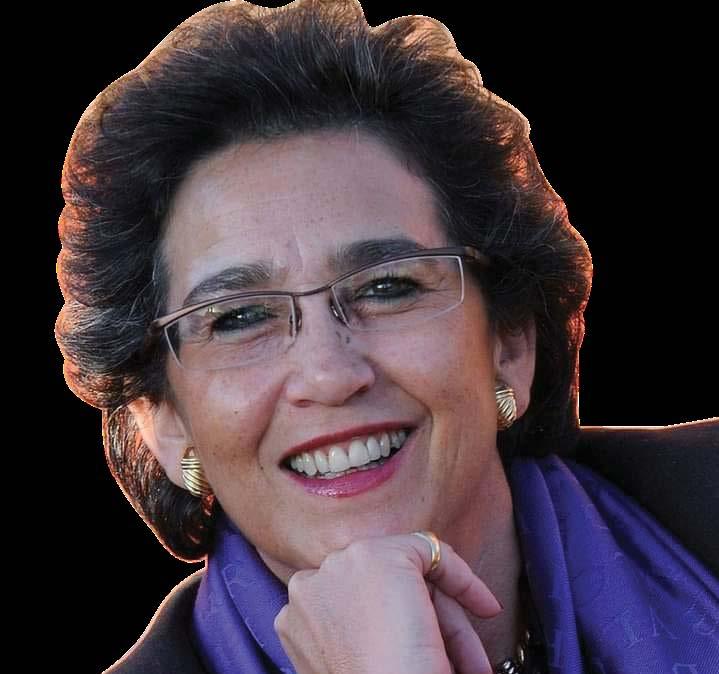
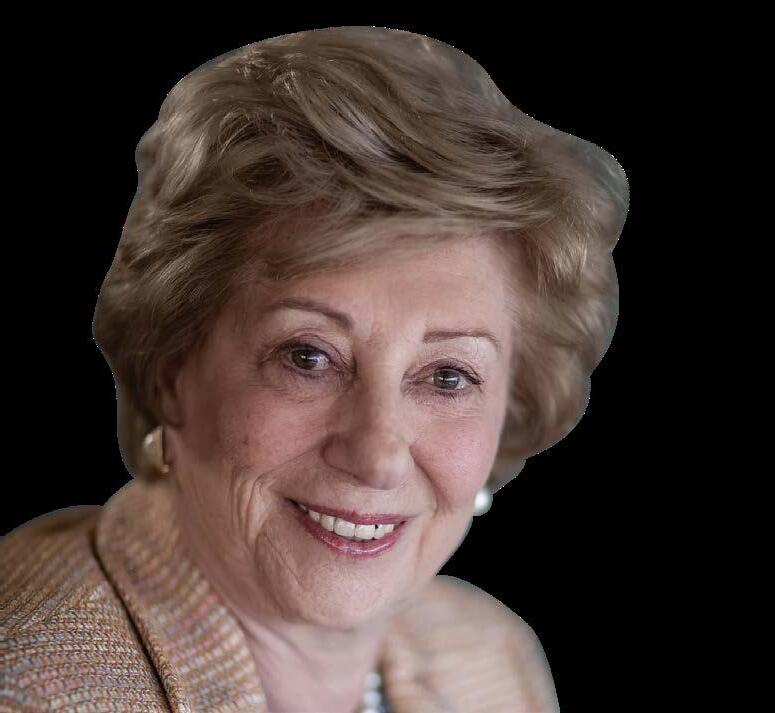
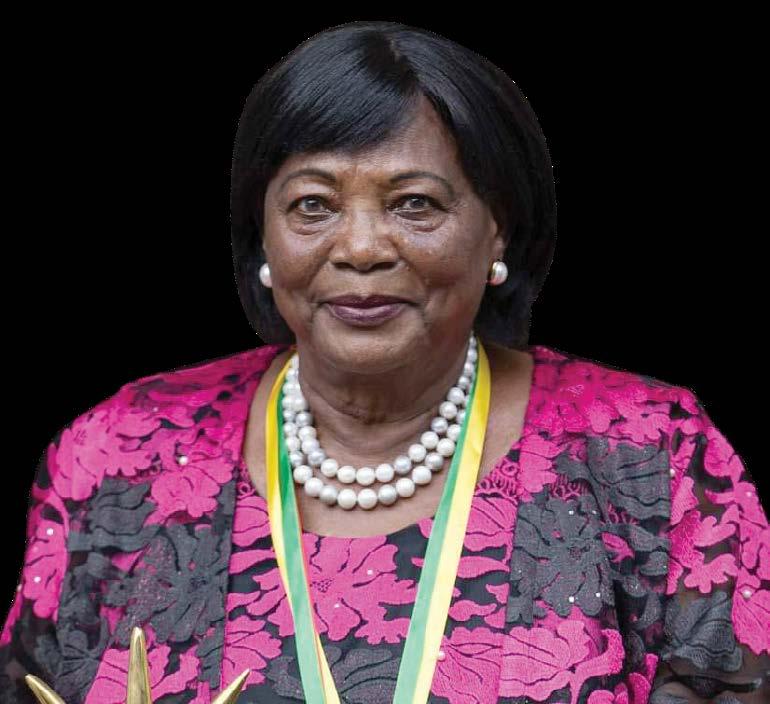
 BY FIONA WAKELIN
BY FIONA WAKELIN
AND WHO HAS TUMBLED FROM THE TOP?














































Looking at the list of the richest women in Africa, what is striking is that acquiring billionaire status does not happen overnight. Everyone featured here has spent a lifetime investing in, and growing, their entrepreneurial empires. Silver hair and gold in the bank!
 Top to bottom: Folorunsho Alakija; Ngina Kenyatta; Hajia Bola Shagaya; Wendy Ackerman; Wendy Appelbaum
Top to bottom: Folorunsho Alakija; Ngina Kenyatta; Hajia Bola Shagaya; Wendy Ackerman; Wendy Appelbaum
TOPPING THE LIST OF WEALTHY POWERHOUSES IN AFRICA IS:
Folorunsho Alakija - a Nigerian billionaire
Fifty years ago Folorunsho started out in the fashion industry and today her business interests include real estate, oil and gas and printing.
She is the owner of several groups of companies including Dayspring Property Development Company Limited, a real estate company which owns properties around the globe, as well as Rose of Sharon Prints and Promotions.
Folorunsho is also Executive Director of FAMFA Oil, her familyowned oil production company.
NEXT IS:
Ngina Kenyatta - the mother of current Kenyan president, Uhuru Kenyatta
Nearing her ninth decade
Ngina Kenyatta is a billionaire with a portfolio which includes investments, banking, media and the dairy industry. “Mama Kenyatta” has a 24.91% share in the Commercial Bank of Africa (CBA) – she also owns shares in Media Max, a media company that owns K24 TV, Kameme Radio, and The People newspaper.
THIRD PLACE GOES TO:
Hajia Bola Shagaya who also hails from Nigeria
With a current net worth of almost a billion US, Hajia Bola started out as an auditor for the Central Bank of Nigeria and then her entrepreneurial verve kicked in! She started an empire by importing Konica photographic equipment for resale. Nearly 40 years later she is CEO of Bolmus Group International with interests in oil, real estate, banking, and photography. Hajia founded Practoil Limited, and in 2005 became its managing director. Today Practoil is one of the largest importer and distributors of base oil in Nigeria today.
4TH AND 5TH PLACES ARE HELD BY SOUTH AFRICAN POWERHOUSES:
Wendy Appelbaum is the richest woman in South Africa and the 4th wealthiest on the continent
Wendy Appelbaum is the daughter of Liberty Group founder Donald Gordon and the owner and Chair of De Morgenzon Wine Estate. Previously, Wendy also served as the Deputy-Chairman of the Women’s Investment Portfolio Limited (Wiphold Limited), which is a renowned women’s investment holding company that is listed on JSE. Overall, Wendy is also a director of Sphere Holdings (Pty) Ltd, which is a black empowerment company
addressing financial services in mining sectors. In 2015, she was awarded both the Forbes Woman Businesswoman of the Year, and the Forbes Africa Woman of the Year.
Wendy Ackerman –FMCG powerhouse
Wendy Ackerman is one of the founders and an Executive Director of Pick ‘n Pay Stores. Along with her husband Raymond Ackerman, Wendy has been a tremendous force in building up one of South Africa’s leading FMCG retailers, which, to date, consists of over 450 stores, with the inclusion of 121 supermarkets and 14 hypermarkets.
The company extends its food and retail services across South Africa, southern Africa and even Australia, and has employed an estimated 49,000 people over the years. Wendy received an Inyathelo Award for her family’s philanthropic efforts in 2007.
A CAUTIONARY TALE
For many years Isabel Dos Santos, daughter of Angolan President, José Eduardo dos Santos, topped the list as the richest woman in Africa. Currently in self-imposed exile in Dubai she is embroiled in legal battles while watching her empire implode. n
Public Sector Leaders | April 2023 | 55







Subscribe to Topco Media’s official Weekly newsletter as we keep you up-to-date with the latest business blogs and articles. www.topco.co.za topco media 56 | Public Sector Leaders | September 2023 10 Well-managed
1 2 3 4 5 6 7 8 9 10
SOEs in Africa
These entities have shown strong management practices, operational efficiency, and contributed significantly to their respective industries:


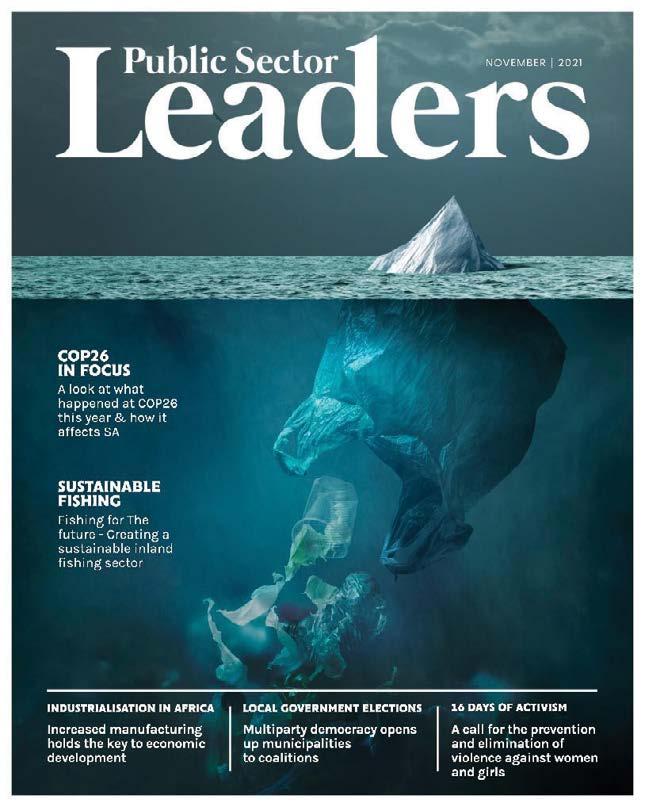
Sonatrach
Algeria’s national oil company, known for its efficient operations and effective management in the oil and gas industry.


Ethiopian Airlines
Recognised as one of the most successful and well-managed state-owned airlines in Africa, with a strong reputation for safety and reliability.



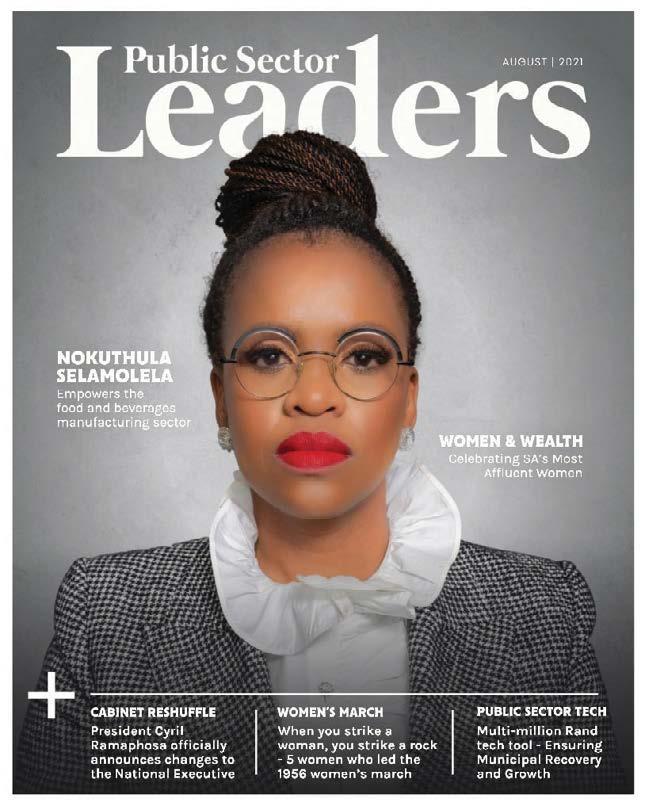
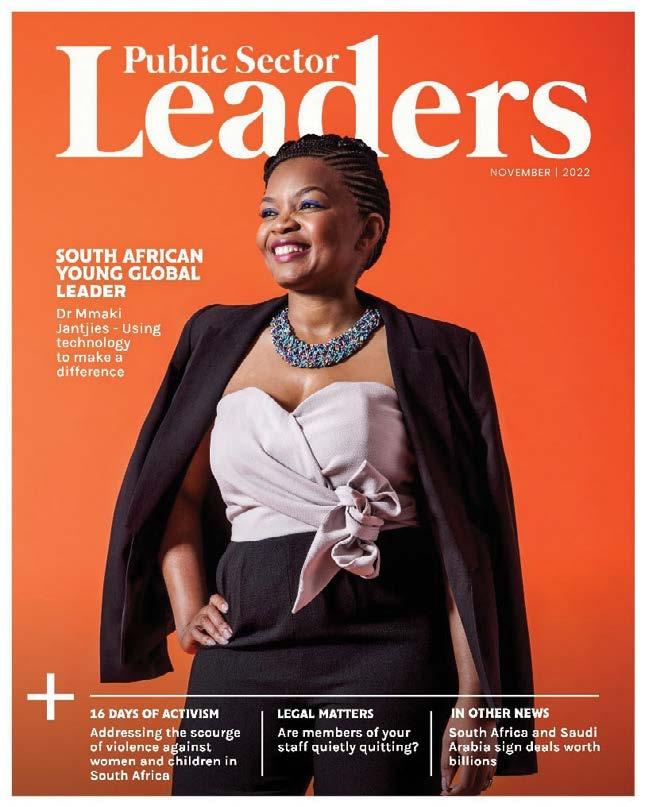
SAFCOL
SAFCOL is a state-owned forestry company in South Africa, under the department of Public Enterprises (DPE), primarily involved in the forestry industry with operations in Limpopo, Mpumalanga, KwaZulu-Natal, as well as in the southern half (Manica and Sofala provinces) of Mozambique.

Botswana Power Corporation
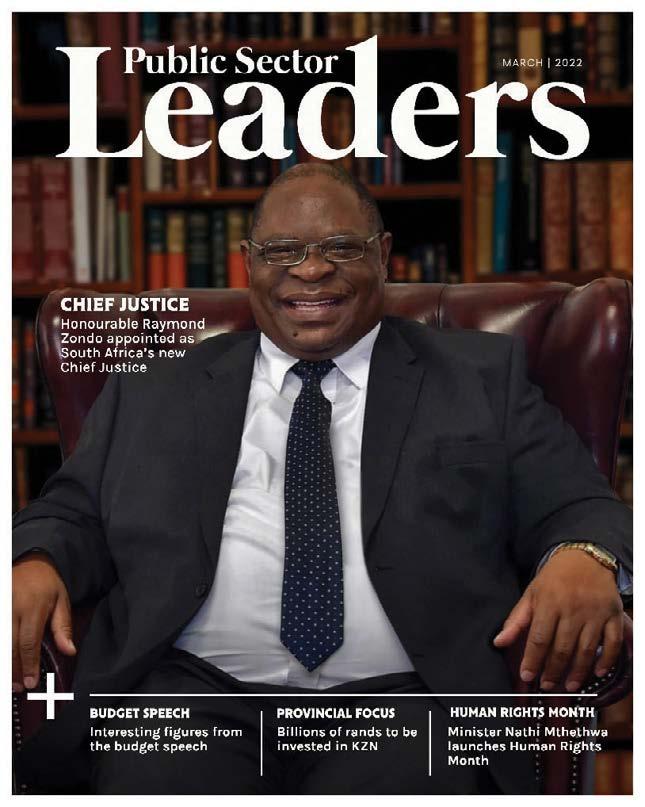
Known for its efficient management of electricity generation and distribution, ensuring reliable power supply across Botswana.
Kenya Ports Authority
Known for its effective management of ports and maritime services, contributing to Kenya’s trade and economic growth.
Tanzania Ports Authority

Known for its effective management of ports and maritime services, facilitating international trade and economic development.
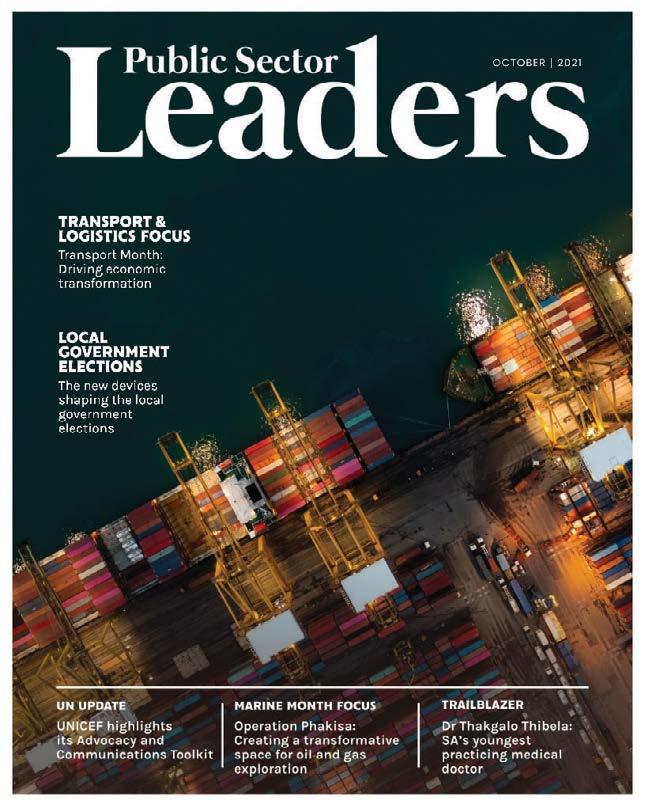
5. Morocco Regarded as a wellmanaged state-owned railway company, providing reliable and efficient passenger and freight transportation services.
Office National des Chemins de Fer (ONCF)
Nigerian National Petroleum Corporation (NNPC)


Despite challenges, NNPC has made strides in improving its management practices and operational efficiency in the oil and gas sector.
Air Algérie
Managed efficiently, Air Algérie is recognised for its reliable operations and services in the aviation industry.
Ghana National Petroleum Corporation (GNPC)
Well-managed state-owned oil company, involved in exploration, production, and marketing of petroleum resources.
These entities have shown strong management practices, operational efficiency, and contributed significantly to their respective industries. n
Proudly Brought to you By
Scan the QR code to book your spot
“Whether you are in the public sector, the private sector, supply chain or an interested individual, PSL has something for you“
September 2023 | Public Sector Leaders | 57
1. Algeria
4. Botswana
7. Kenya
10. Tanzania
6. Nigeria
2. Ethiopia
3. South Africa
8. Algeria
9. Ghana



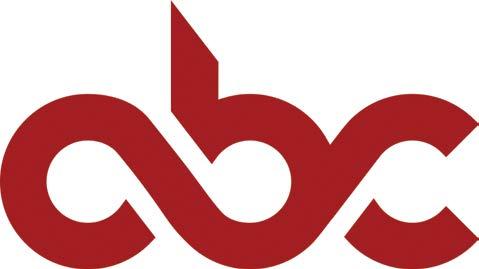
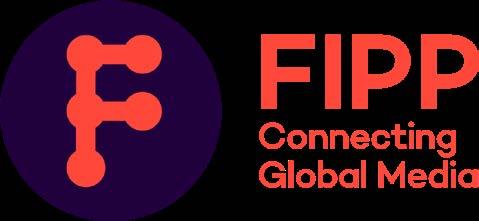
info@topco.co.za 186 Loop St, Cape Town City, Centre, Cape Town, 8001, 0860009590 topcomedia_ Topco Media @Topco_Media @TopcoMedia Topco Media topco.co.za www Go to our website





































































































 BY FIONA WAKELIN
BY FIONA WAKELIN













































 Top to bottom: Folorunsho Alakija; Ngina Kenyatta; Hajia Bola Shagaya; Wendy Ackerman; Wendy Appelbaum
Top to bottom: Folorunsho Alakija; Ngina Kenyatta; Hajia Bola Shagaya; Wendy Ackerman; Wendy Appelbaum



































